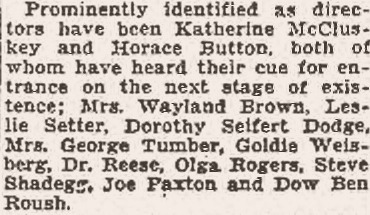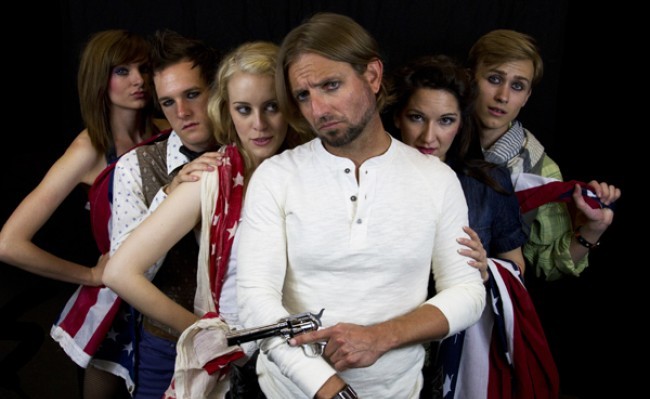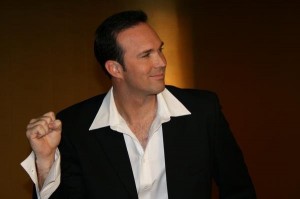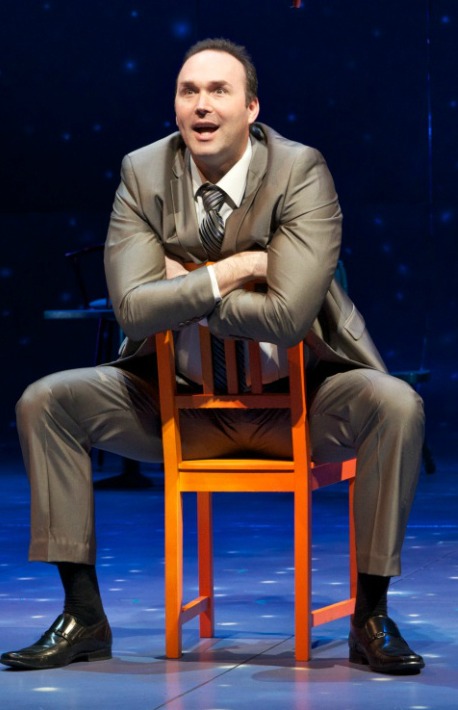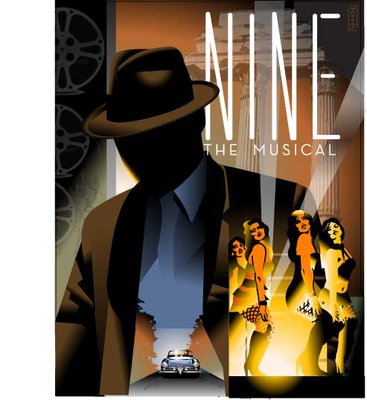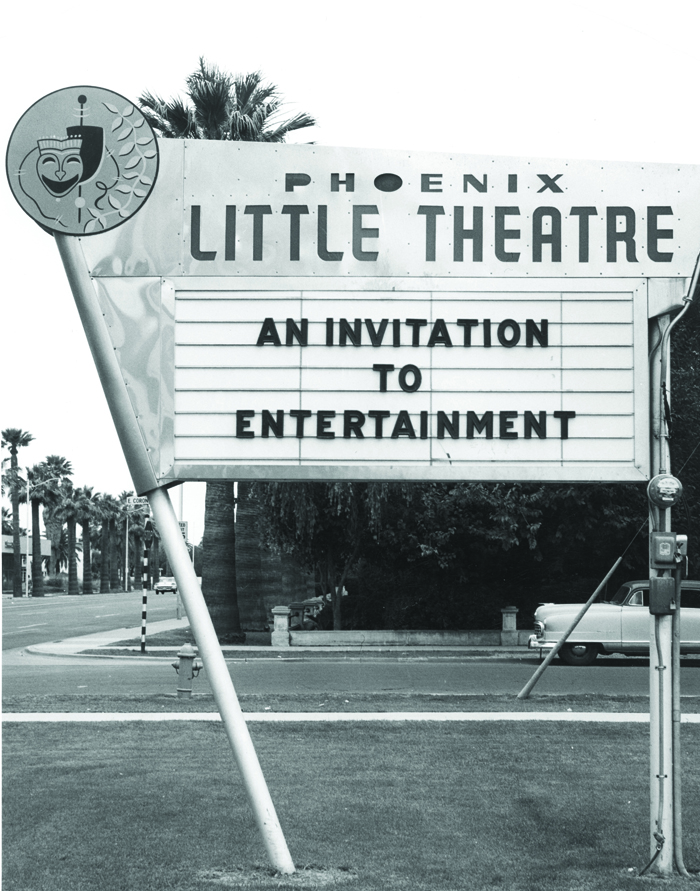


- 2014-2015 SEASON
Memphis . September 17, 2014 to October 12, 2014; Shear Madness . October 29, 2014 to November 23, 2014; Mary Poppins . November 19, 2014 to December 28, 2014; Two Pianos, Four Hands . January 14, 2015 to February 1, 2015; Buyer & Cellar . February 25, 2015 to March 22, 2015; End of the Rainbow . April 29, 2015 to May 17, 2015; One Man, Two Guvnors . May 20, 2015 to June 14, 2015
- A BRIEF HISTORY
- Includes source material from the theater website.
Phoenix Theatre was originally founded as the Phoenix Players by Harry Behn, Katherine Wisner McCluskey and Mrs. Maie Bartlett Heard in 1920, making it the oldest arts organizations in Arizona and one of the oldest operating arts organizations in the country.
(The 1920 date is contested; some references say it occurred in 1922. The theater seems to be on the side of 1920. It officially celebrated its 65th anniversary in 1985.)
Harry was straight out of the drama program at Harvard University. Katherine ran her own drama school here and Maie was the wife of Dwight Heard, publisher of the Arizona Republican (the predecessor of the Republic.)
Now that Phoenix was a stop on a major cross-country train route, they felt the city needed a quality theater to add to its lustre. Harry was inspired by the little theatre movement that originated in Europe and swept the East Coast earlier in the century.
The movement had the goal of freeing theater from the stuffy state-subsidized (and state-censored) houses and putting it into the hands of smaller, creatively uninhibited and publicly accessible facilities.
Harry soon left Phoenix for Hollywood, where he wrote the scenario of The Big Parade. The silent film epic followed a young American soldier as he fought in France during World War I. Starring John Gilbert, it was the biggest box-office hit of the 1920s, running for more than two years at a New York cinema. The picture’s success established Metro-Goldwyn-Mayer as Tinsel Town’s leading studio.
Harry also worked on the screenplays for La Boheme, The Crowd and Hell’s Angels, three other hits of the silent era.
For a biography of Harry Behn, go HERE
For a biography of Maie Bartlett Heard, go HERE

The Phoenix Players were a nomadic lot. Opening with Shakespeare’s A Midsummer Night’s Dream, they performed in schools and music studios, on front lawns and in backyards (shades of Is What It Is in the 2000s). They needed a permanent home and Maie’s family came to the rescue. The Heards gifted the players with their coach house, located at Central and McDowell avenues.
In spite of its fancy name, The Old Coach House, it was more like putting on a show in a barn -a very hot barn in summer (patrons learned to bring fans) and a very cold one in winter (layers, layers, layers). The company did install a swamp cooler, but it made so much noise they could only turn it on before the show and at intermission. God forbid there was a thunderstorm. One bolt and the lights went out. The show did not always go on.
The Old Coach House was introduced to the public with an appropriately titled “dramatic evening,” including the play, One Room Plus. It was at this point that Victor Kolberg, Marriott McMaster and Mrs. C.H. Young began their long association with the theater as directors and performers.
At first, the seats were wooden benches. No backs. Ouch! Later, those were replaced with folding chairs. Not much better. Finally, someone donated padded seats. Ah, luxury!
Every year, the fire marshal condemned the structure. Every year, the theater made just enough improvements to get it through another season.

The company’s first full season was in 1922. Publicity declared “This is your theater. Enjoy it to the fullest.” It was also in 1922 that the company began using the name, Phoenix Little Theatre, although it wasn’t until 1929 that it officially applied for articles of incorporation.
In 1924, the tradition started of staging the last show of the season out-of-doors. (The Heards donated the use of their front lawn.) This lasted for a number of years until pesky bugs, changeable weather and erratic sound and light systems shooed everyone back inside for good.
In the following clippings from the Arizona Republic, the names of performers and directors who were prominent in PLT’s first years are listed.
While the infrastructure may have had its problems, audience growth was steady. Eight years after its founding, the company had 424 members, a respectable number given the city’s population was under 40,000 at the time. Subscription prices were $3 for six plays!
In the 1930s, PLT instituted formal children’s training in drama under the auspices of Dorothy Seifert Dodge. Olga Rogers began a program called the Phoenix Junior Players for high school and junior college students. The group performed and rehearsed at PLT.
In 1937-1938, the company’s budget was slightly more than $2,000. As of Sept. 15, 1937, it listed of revenues of $2,278.71 against expenditures of $1,523.71, leaving it in the black to the tune of $755.
At the onset of World War II, the company had nearly 1,000 members. When war actually broke out, PLT didn’t close, providing entertainment for conflict-weary Phoenicians and running an open house for any troops that were in town (especially those from the big Air Force base to the east – now Luke AFB).
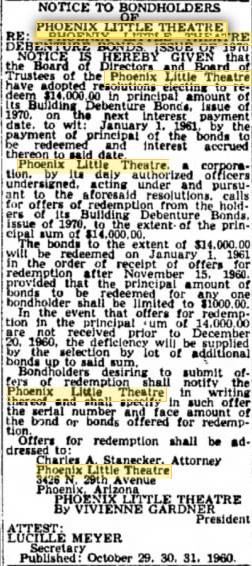
The company had long since outgrown the stables. In 1952, Stephen Shadegg, president of the theater’s board of directors, joined with Heard family members and Sen. Barry Goldwater to win funding for the construction of a new building at the Central and McDowell site. This structure became known as the Phoenix Civic Center and anchored an expanding arts and cultural area that would later encompass the Phoenix Art Museum and the Phoenix Library (and, still later, the Playhouse on the Park at the Viad Corporate Center).
Financially, the years have been a roller coaster ride for the theater. One major financial lurch happened in the mid-60s. (For details, scroll to the end of this page, and click on PLT in the 1960s) Put simply, PLT could no longer pay its bills. Its paid staff, including resident director Olan K. “Kit” Carson was let go, and the organization became dependent upon volunteers.
The crisis was solved, as it had been solved before and would be again, by the Phoenix City Council coming to the rescue. Ironically, the council cited the hard work of Carson in helping put PLT back on its feet.

In 1981, the company underwent another name change. Now known as Phoenix Theatre, it embarked on several renovations to the 1950s structure and made several additions to programming, many of which are still in operation today.
In 1985, the company its 65th anniversary. President Ronald Reagan sent his congratulations.
In 1999, the company was back in crisis mode. Both the artistic director of the day, Michael Mitchell, and managing director Denise Ford resigned. Though the pair had done much to restore PLT’s lustre, it was generally felt that the company had lost its relevance, playing host to warhorse musicals and comedies rather than offering the daring theatrical choices of an earlier day. (See a copy of Kyle Lawson’s column on the situation below.)
But this crisis passed, as did the ones before. PLT was an unstoppable force.
One legacy of the Mitchell-Ford reign: The theater officially dropped the “Little” from its name, becoming Phoenix Theatre. There was a fair amount of controversy about this. Some people thought the name change signified the end of PLT as a community organization. There was some truth in that. Though it had never been a typical community theater, in later years PLT did become a professional operation, regularly using Equity performers. The concept of the “noble amateurs” become a historical footnote, as it did in theaters across the nation.
(Another thing for which I will always remember Michael Mitchell: He gave many actors a chance they would never have had at another theater. For instance, he cast the young Sally Jo Bannow as Blanche in Tennessee William’s A Streetcar Named Desire. Her interpretation was unique and fascinating! That production also contributed to the fashioning of Terey Summers into star material.)
In 2006, the company developed a plan to address the shortage of space and accommodate the growing needs of its programs. Bond issues were floated and passed. Changes were instituted that made the theater ever more accessible. The theater closed its beloved upstairs stage, Theatre One, which would have been prohibitively expensive to renovate to provide handicapped access. It opened a new black box space in a building across the courtyard from the main stage.
Then, in 2013, the theater announced one of the most significant expansions of a performing arts facility in the southwest. The addition featured a soaring glass atrium lobby, additional rehearsal and entertainment spaces. and a new state-of-the-art black box theatre. It was renamed the Hormel Theatre.

Through the course of its history, Phoenix Theatre has launched stars in the industry, developed young audiences, introduced emerging playwrights and composers, created a space for alternative and experimental theatre and hosted world premieres.
Most importantly, it remains at the center of an active arts complex serving its audiences by creating dynamic, professional productions while following its mission of educating and elevating the growing Phoenix artistic and cultural community.


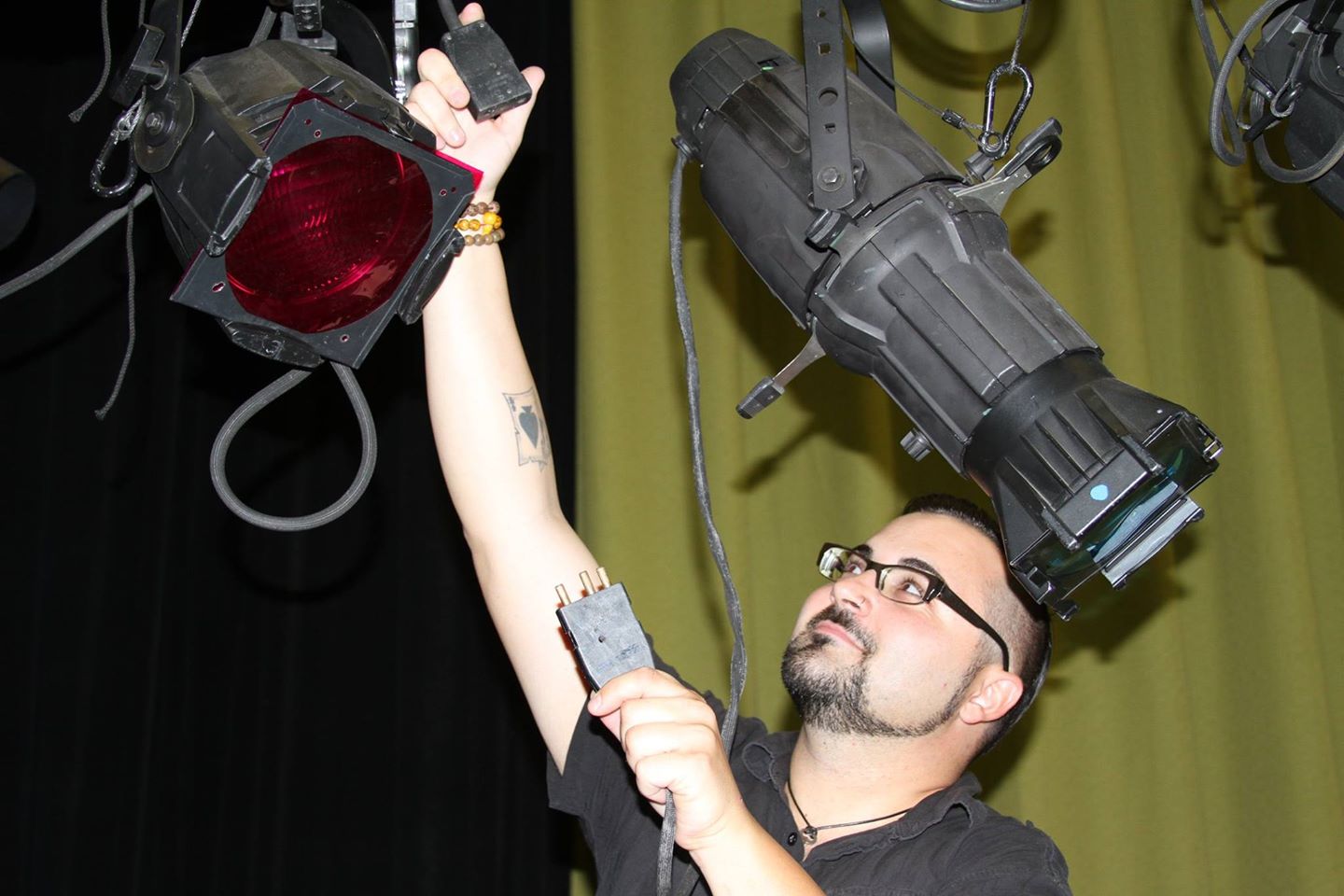
- COOKIE COMPANY
Alan J. Prewitt began the Cookie Company in 1980 to bring professional-level theatre to children and their families. It was one of the first theaters in the Valley to consistently perform original works, some of them in Spanish. It was the first children’s theatre to provide shadow-signed and audio reverse interrupted performances for deaf children.
The Quiltmaker’s Gift by Prewitt and Craig Bohmler, was, for a time, the theater’s annual holiday attraction.
In its prime, Cookie Company served more than 35,000 cookies a year and more than 500 gallons of milk. Prewitt once estimated that, over the years, that added up to more than 980,000 cookies and 14,000 gallons of milk.
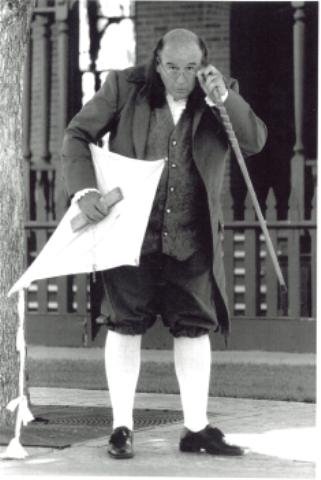
- FAMOUS FACES
Phoenix Theatre has had more than a few stars share its stage over the years. From playwrights and authors, to television and film actors, PT has been home to those who went on to make a name for themselves as well as those who stopped by with their reputations preceding them.
Harry Behn’s wasn’t the only famous face to be found in the wings. Clare Booth Luce, an American ambassador and writer of such hits as The Women, spent time at PLT. And Andy Devine, Beverly Garland, Rosemary DeCamp and Susan Flannery all went on to have successful film and television careers after spending some time here. Nick Nolte called PLT home on several occasions. He appeared in 1963 in Squirks and then played Prince Charming in Cinderella. He also starred in The Golden Fleecing in 1964 and portrayed Starbuck for Actors Inner Circle in The Rainmaker. L. Ron Hubbard began his teaching of Scientology on PLT’s Main Stage in the 1950s. Steven Spielberg screened his first film, Firelight, at the theatre in 1964.
- BOUND FOR GLORY – WITH A SLIGHT DETOUR
In the 1930s, a young Kingman actor took to the stage at PLT. When I first came to the Valley in the late 1970s, old-timers still remembered Andy Devine.
“I think the thing that stood out most about Andy was his voice,” David Berge told me in a 1977 interview. “It sounded like you were scraping the bottom of a barrel. The directors didn’t know what to do with him. But he was such a likeable kid that one of them finally gave him a part. I think he had two or three lines. The problem was, he was so scared he couldn’t remember them on opening night. He went up. That scared him even worse. He ran off stage – only where he thought there was a door, there was a window. He went right through it. Everyone gave him hell – in a funning way – after that. It wasn’t long before he went off to Hollywood.”
Andy had much better luck at the studios. He soon was being cast (or miscast as in 1936’s Romeo and Juliet as one of Juliet’s servants) in big productions like In Old Chicago and A Star Is Born. In 1939, he was back in his home state in one of his most memorable roles, the driver in John Ford’s classic western, Stagecoach. — Kyle Lawson.
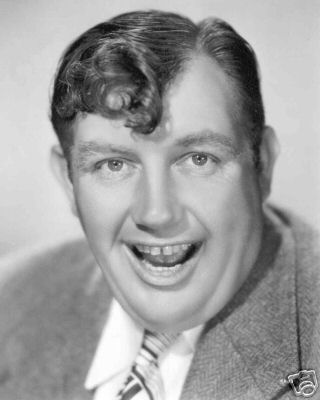
- HAVE ANY JESTERS SURVIVED?
For many years, Phoenix Little Theatre handed out annual awards for the best work of the season. In 1963, Helen Begam spearheaded a campaign to create the Jester, a copper-colored, 16-inch trophy designed by PLT’s technical director George Pettit and cast by Valley jeweler Robert Tennen. Just exactly who took the little man home is not clear from the record. Do any survive?

- Read more about Phoenix Theatre HERE
- Actors Inner Circle regularly performed at PLT. For the company page, go HERE
- I would like to thank Sara Chambers, Steven Mastroieni, Jacqueline Gaston, Lin Haring and Barbara Walker McBain for their help in creating this page.
2013-2014 SEASON
Main Stage: August-September, Rent. October, The 39 Steps. November-December, White Christmas. January-February, Ain’t Misbehavin’. March, Pippin. April-June, Les Miserables.
Hormel-Black Box Theatre: September-October, Ruthless: The Musical. January-March, Tribes. April-June: Avenue Q.
- LES MISERABLES
- Music: Claude-Michel Schonberg.
- Book: Alain Boublil and Jean-Marc Natel. Based on the novel by Victor Hug.
- English language libretto: Herbert Kretzmer.
- Cast: Doug Webster, James Zanelli, Christopher Behmke, Jenny Hintze, Karenessa LaGear, Terey Summers, Michael Sample, Joseph Cannon, Caleb Reese, Brian Sweis, Matravius Avent, Rochelle Barton, Zack Bender, Elizabeth Brownlee, Nic Bryon, Emilie Doering, Bjorn Eriksson, Katie Frederick, Ashley Fredricksen, Aydin Golabi, Cullen Law, Bethany Lorentzen, Ashley Dutson, Scott Schmelder. Boston Scott, Evan Tyler Wilson, Emme Maravich, Morgan Karam, Nick Pauley and Austin Porter.
- Comments: In 2009, Phoenix Theater produced a Les Miserables that changed the way many people thought about that megamusical. The show was famous for spectacle, including massive moving barricades during the revolt scenes. The PT production retained a sense of grandeur while simplifying the settings. Lighting played a more important role than canvas and wood in creating the mood. That production proved to be immensely popular, so, in 2014, the company brought a revival to the boards. The new show was true to the original in concept and boasted a cast that was, if anything, stronger. It, too, was a huge hit.

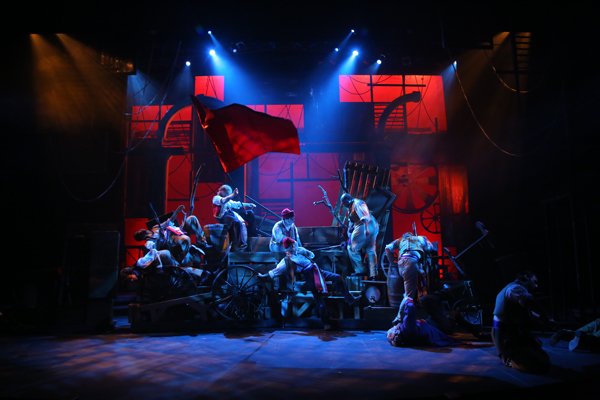
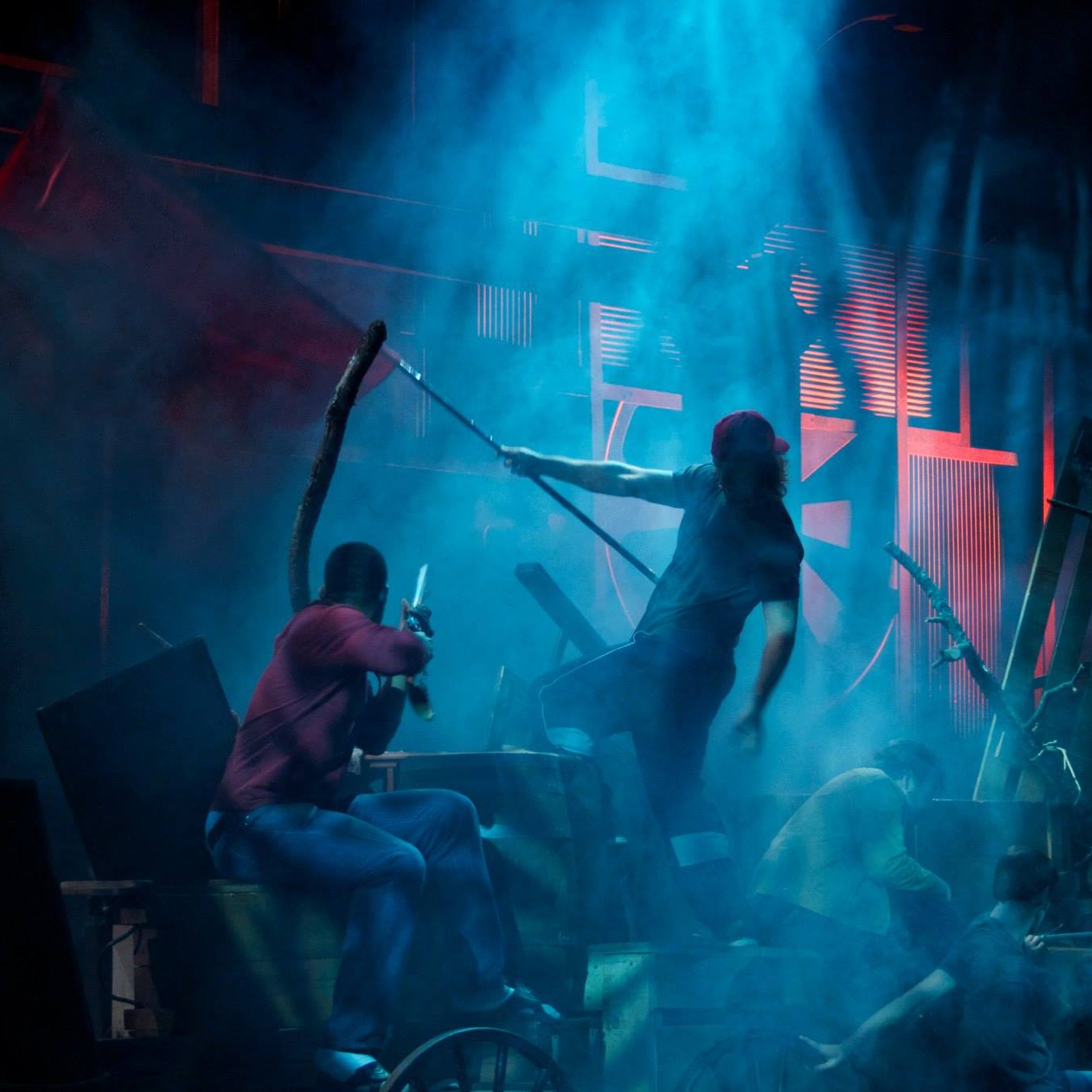

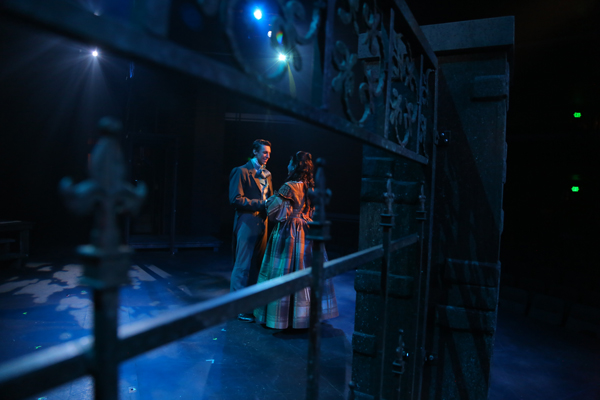
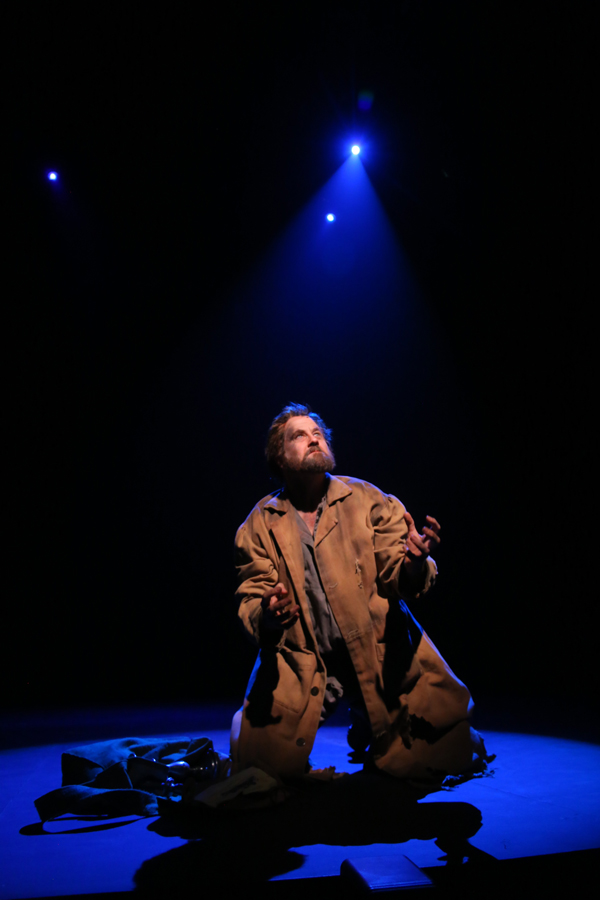
- AVENUE Q
- Music & Lyrics: Robert Lopez, Jeff Marx.
- Book: Jeff Whitty.
- Director: Robert Kolby Harper.
- Cast: Toby Yatso, Emily Mulligan-Ferry, Pete Good, Colin Ross, Marisha Castle, Brittney Mack, Aya Nameth, Catherine Wong.
- Comments: It was a season for revivals. As well as Les Miserables, Avenue Q returned to the PT stage. And, like the Les Miz remount, the raunchy puppet musical was a solid money spinner. It benefited from the return of Toby Yatso and Emily Mulligan-Ferry, who had been in the initial outing.
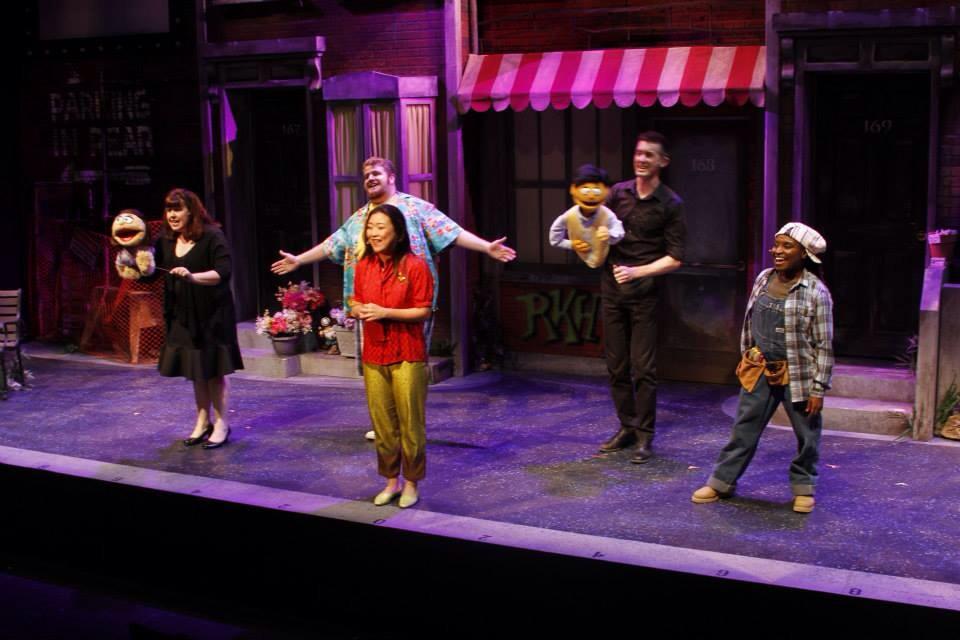
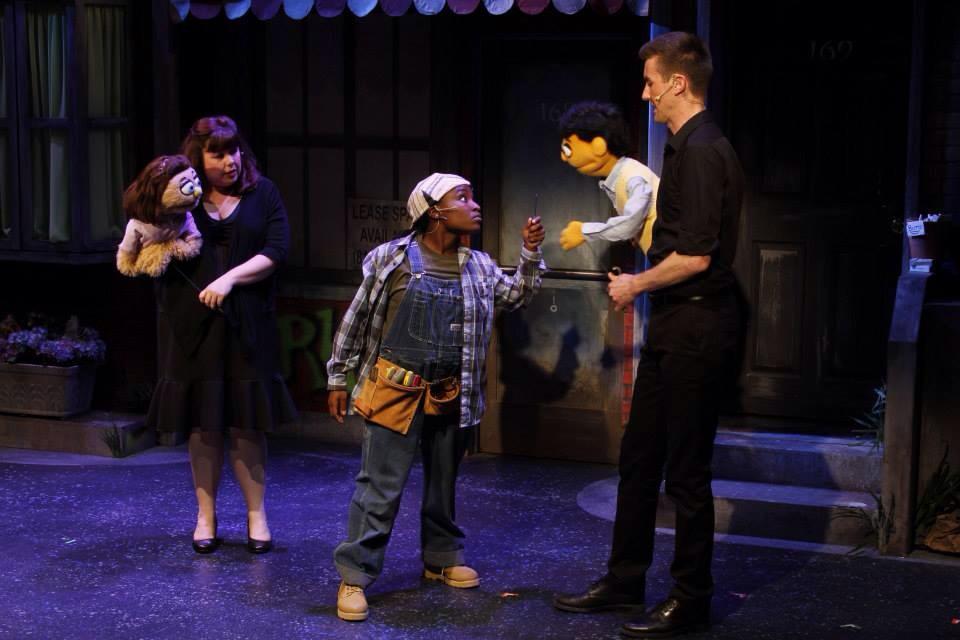
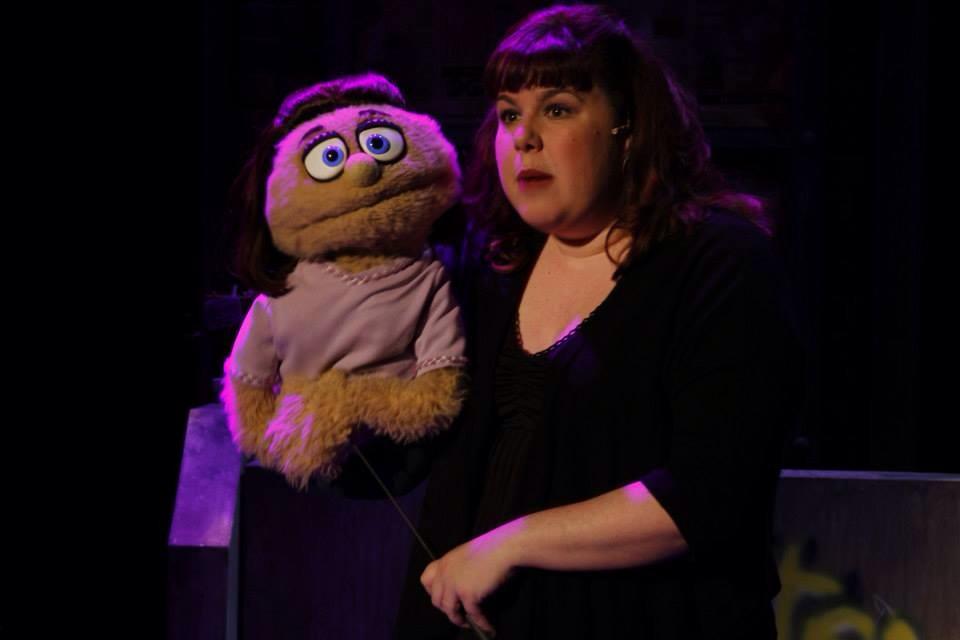
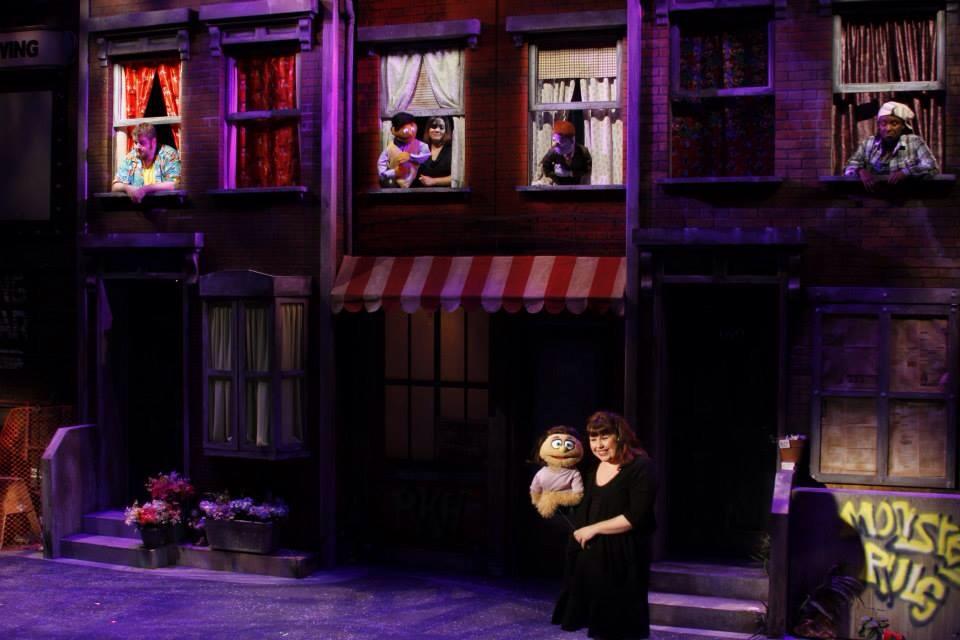
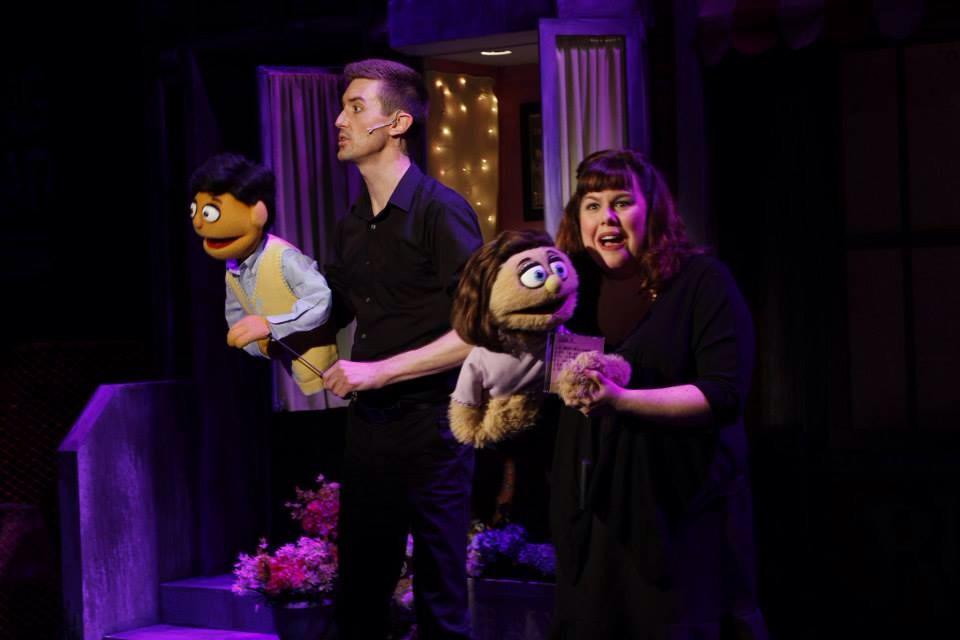
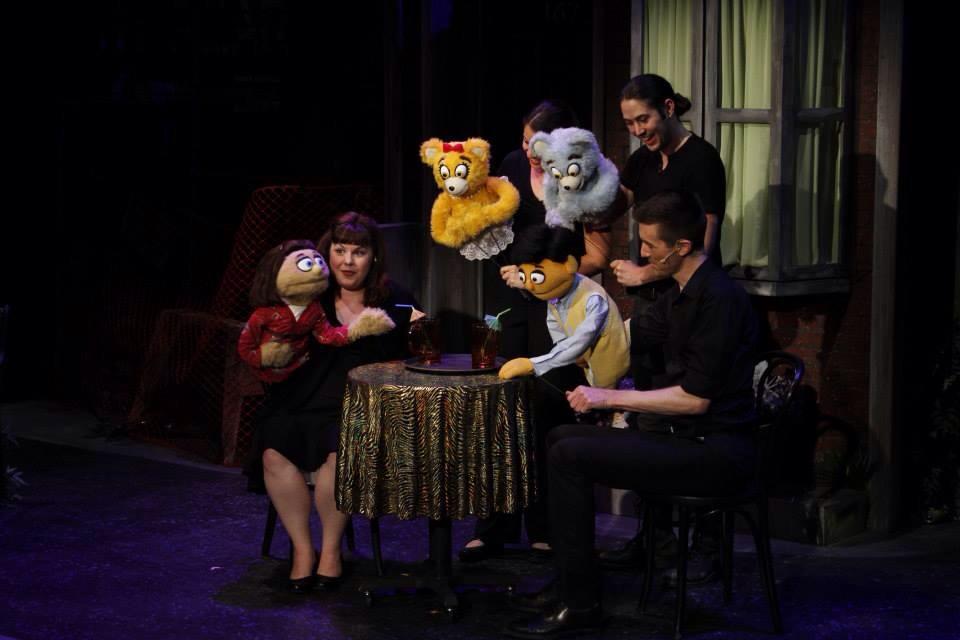
THE CAST OF ‘AVENUE Q’ IN MOTION ….
- PIPPIN.
- Music & Lyrics: Stephen Schwartz.
- Book: Roger O. Hirson, Bob Fosse.
- New York Premiere: 1972
- Director: Michael Barnard.
- Cast: Paul Oakley Stovall, Anthony Johnson, Jenny Hintze, Trisha Hart Ditsworth, Kathi Osborne, others.
- Sets: Robert Kovach.
- Lighting: Michael Eddy.
- Costumes: Cari Sue Smith.
- Comments: Back when I first arrived in the Valley, Michael Barnard directed a production of Pippin. It was a pip. OK, I couldn’t resist that, but it was very, very good. So was his 2014 revival, this time set somewhere between Cirque du Soleil and a true circus. It was, in a word, spectacular. Well-sung, interestingly choreographed, it offered ample evidence that Michael has been the Valley’s preeminent director-choreographer – well, ever since I’ve known him. A word should also be said here for Jenny Hintze’s amusing, sultry Fastrada. Jenny, too, may become preeminent.
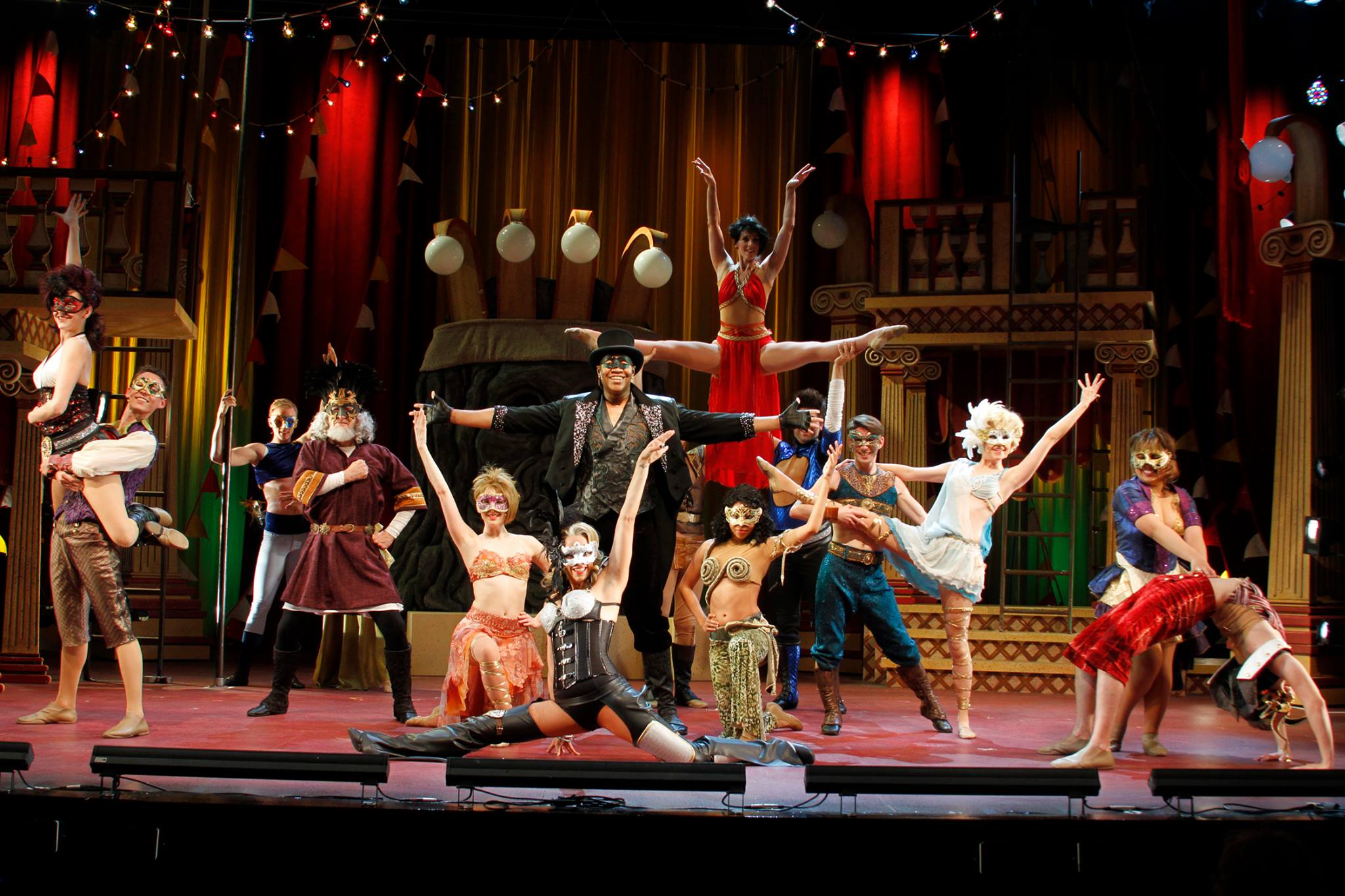
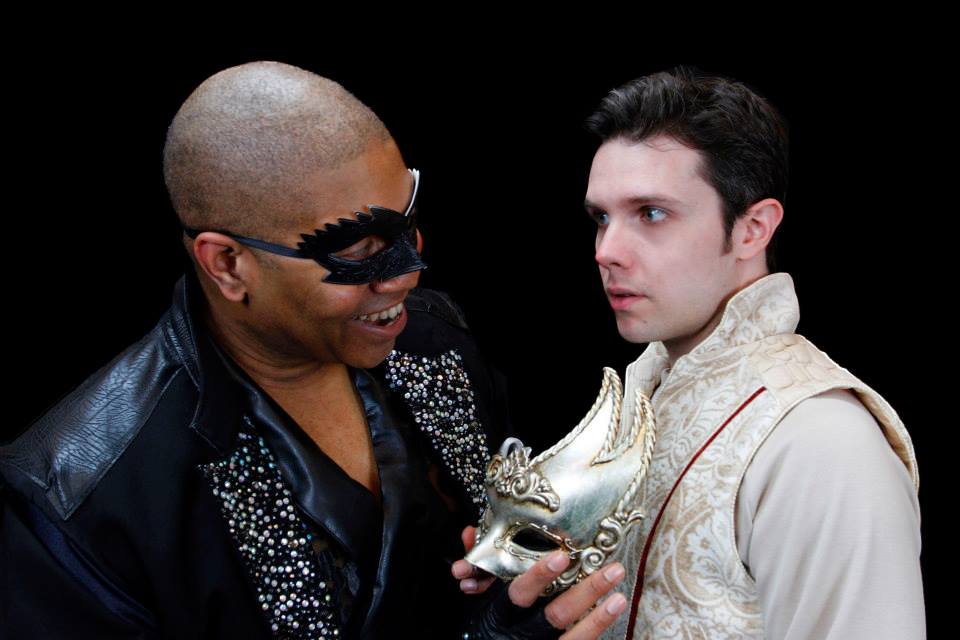

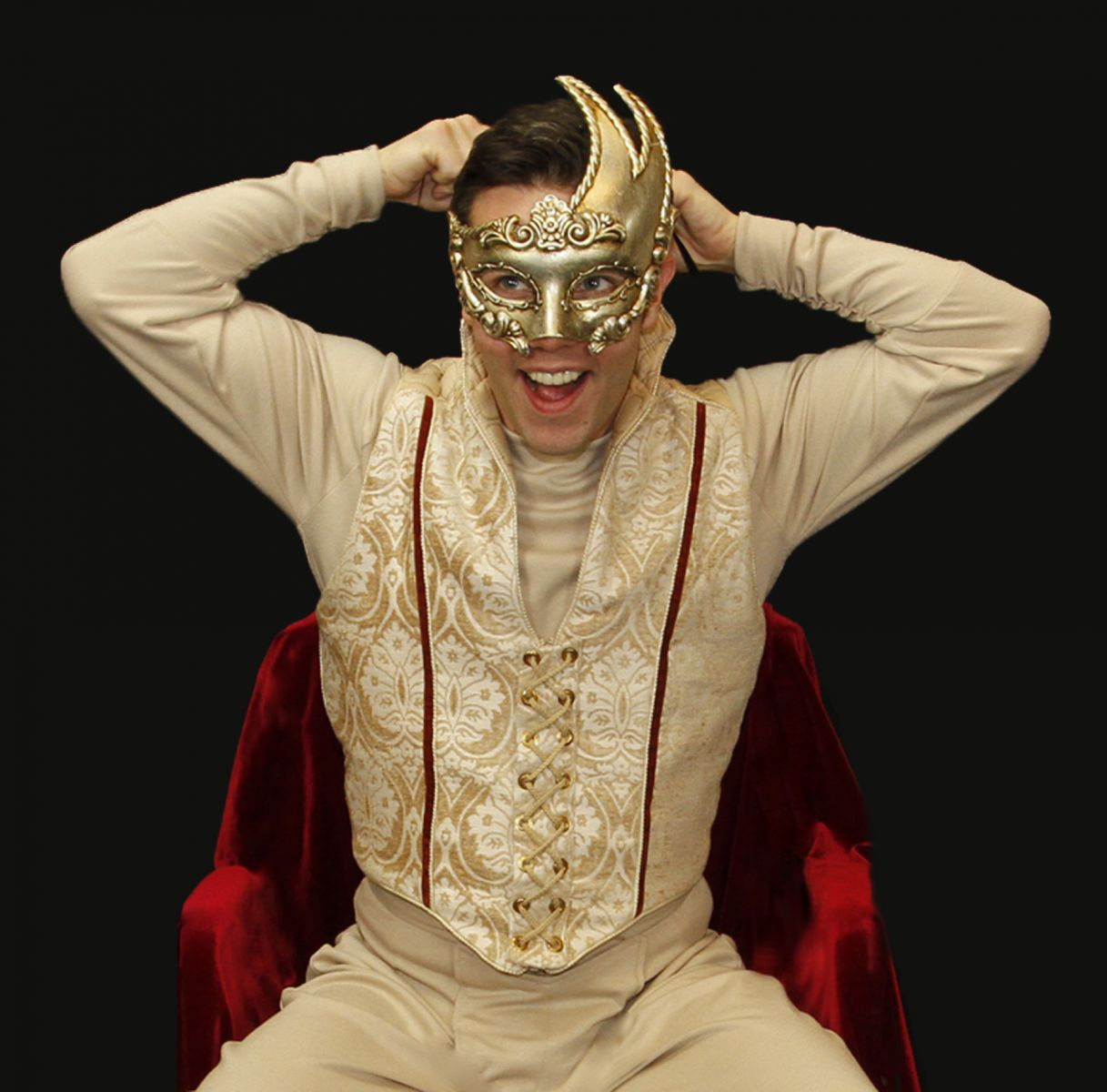
For Kerry Lengel’s review in the Arizona Republic, go HERE
- TRIBES
- Playwright: Nina Raines.
- Director: Paul Barnes.
- Cast: Willem Long, Gabrielle Van Buren, Marshall Glass, Cathy Dresbach, Dion Johnson, Caroline Wagner.
- Comments: Tribes premiered in London in 2010 and arrived in New York in 2012. (It won a Drama Desk Award for outstanding play.) Two years after it opened in the Big Apple, it showed up in the Valley in a well-mounted production at Phoenix Theater. Nina Raines’ seriously funny comedy (it’s both) centered on a dysfunctional British family, one of whom is deaf. When the boy, who has been raised to read lips and has no knowledge of sign language, meets the hearing daughter of deaf parents who is now going deaf herself, everyone’s life is changed. Director Paul Barnes fielded a remarkable cast. A hearing impaired actor, Willem Long, played Billy, the son, to great effect. Gabrielle Van Buren was his equal as Sylvia, the woman he meets. Cathy Dresbach and Dion Johnson nailed their roles as Billy’s parents, unlikable at times but convinced they are doing the right thing. Finally, Marshall Glass and Caroline Wagner shone as Billy’s siblings who loved him but didn’t always understand him. An outstanding production in the company’s long history of outstanding productions.
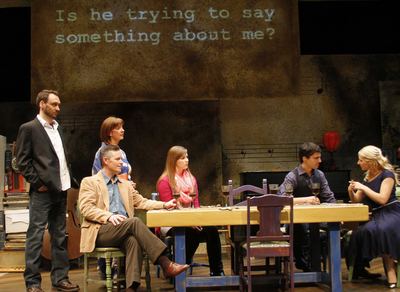
Here’s a video produced about the show.
- AIN’T MISBEHAVIN’.
- Book: Murray Horwitz, Richard Maltby Jr.
- Music: Thomas “Fats” Waller
- Director: Robert Kolby Harper.
- Cast: Walter Belcher, Andre Jordan, Brittany Mack, Katherine Todd, Fredena J. Williams.
- Comments: This musical, conceived by Murray Horwitz and Richard Maltby, Jr., celebrated the music of Thomas “Fats” Waller. That meant songs like “Honeysuckle Rose,” “The Joint Is Jumping,” “I Can’t Give You Anything But Love,” “I’m Gonna Sit Right Down and Write Myself A Letter,” “Mean to Me” and the title tune. It was guaranteed to please the older-skewing audience at PT, and it did, while convincing the younger generation that their parents were hip, or at least liked hip music.

For an article on this show by Kerry Lengel of the Arizona Republic, go HERE; for Kerry’s review of the production, go HERE.
- RUTHLESS: THE MUSICAL
- Opening production at the company’s Hormel Theatre.
- Book and Lyrics: Marvin Laird.
- Music: Joe Paley.
- Director: Michael Barnard.
- Cast: Debby Rosenthal, Johanna Carlisle, Barbara Walker McBain, Rusty Ferracane, Rebecca Duckworth.
- Comments: Tina Denmark is 8 years old and determined to be the biggest star the world has ever seen – no matter what it takes or who gets knifed in the process. This musical spoof inaugurated the new Hormel Theater complex and everyone agreed: the facility was fabulous. So were Ruthless’ three older women: Debby Rosenthal, Johanna Carlisle and Barbara Walker McBain; and its younger one, Riley Glick. You notice I did not say fourth leading lady. How shall I put it? Sylvia St. Croix, Tina’s manager, was a bit manly. (No surprise, since she was played by Rusty Ferracane in drag.)
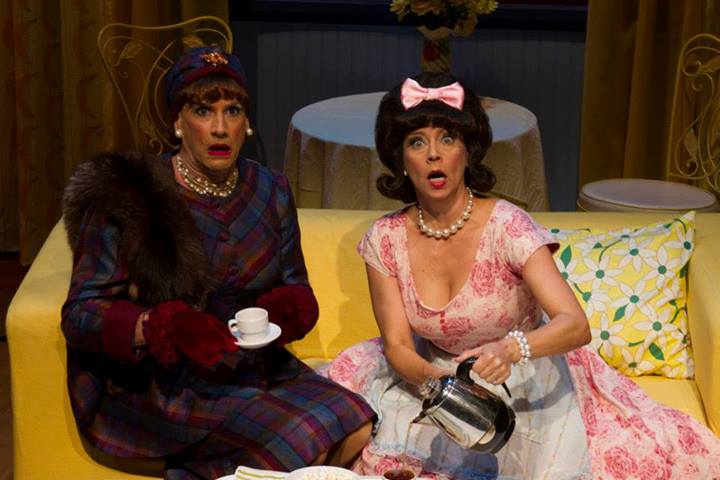
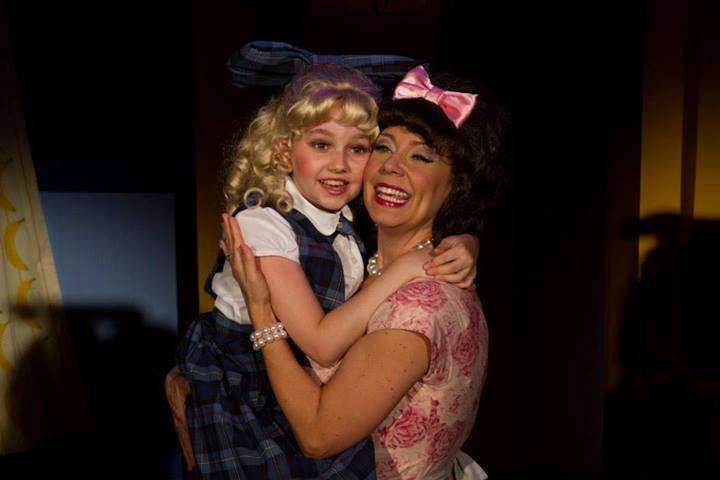
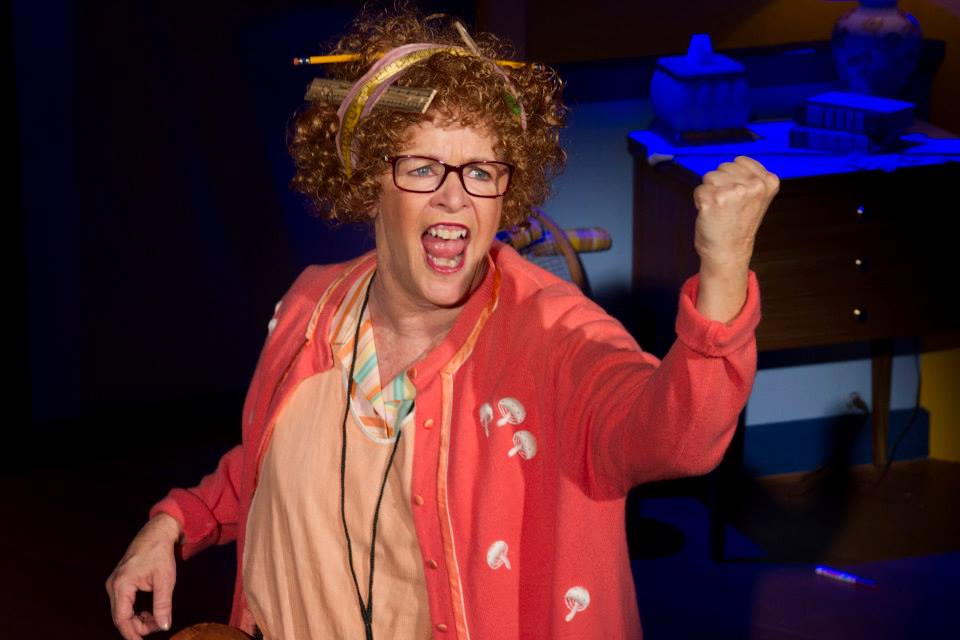
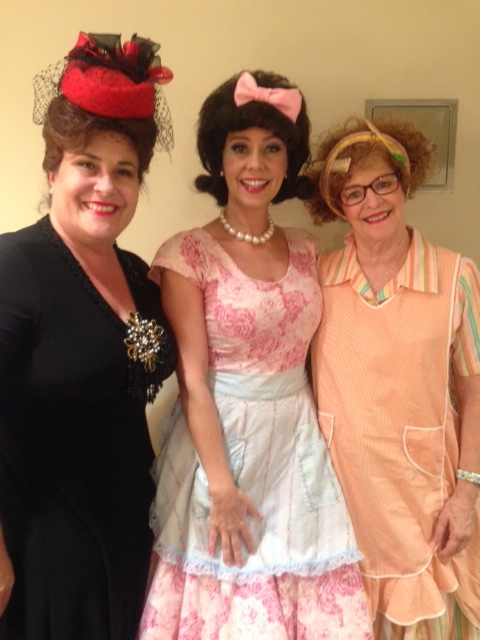
- WHITE CHRISTMAS
- Music: Irving Berlin
- Director: Michael Barnard.
- Choreographer: Kathy Calahan.
- Music Director: Alan Ruch.
- Cast: Joseph Cannon, Peter Marinaro, Debby Rosenthal, Molly Lajoie, Johanna Carlisle, Chris Ericksen, Kate Shein, Terry Lee Gadaire, Pete Good, Jonathan Furedy, Lauran Stanis, Sam Hay, Lucas Coatney, Logan Scott Mitchell, Kenny Francoeur, Darcy Gould-Welch, Laurie Trygg, Lauren Devine, Ally Lansdowne, Marina Jarrette, Jonathan Brian and Kathy Calahan.
- Scenic Design: Robert Kovach.
- Lighting Design: Michael Eddy.
- Comments: Over the years, Phoenix Theater has had to live with snickering from the critics. The charge: It produced way too many “warhorse” musicals. Well, it has always produced musicals, and many of them were revivals of revivals of revivals. But who’s to argue with the public if it chooses to flock to shows by the giants of American musical comedy, the one theatrical art form this nation has produced? It was inevitable that PT would get around to Irving Berlin’s White Christmas, though, somewhat ironically, it was not a musical comedy to start. Berlin wrote the song in 1940, and it was used in the 1942 film, Holiday Inn, starring Bing Crosby and Fred Astaire. Crosby’s recording of “White Christmas” became the best-selling single of all time (a record it still holds). In 1954, Paramount Pictures remade Holiday Inn as White Christmas, with Bing again in the lead (Danny Kaye replaced Fred). The musical is based on the ’54 film. Regardless of the source, a lot of people liked the idea and it seems that most of them showed up at PT to express their approval. Michael Barnard gave the show his usual inventive spin and cast it nicely, with Joseph Cannon (a lovely, deep singing voice), Peter Marinaro, Debby Rosenthal and Molly Lajoie taking the roles played in the movie by Crosby, Kaye, Rosemary Clooney and Vera Ellen. Still, Johanna Carlisle, as the woman who helps the general, Chris Ericksen, run the inn, nearly stole the show. Kathy Callahan, who was in the Broadway production, recreated its choreography here. Mike Eddy’s lighting and Robert Kovatch’s sets were a big part of the show’s success.



This video will give an idea of the show’s style.

- RENT
- Book, Music & Lyrics: Jonathan Larson.
- Director: Robert Kolby Harper.
- Cast: Lucas Coatney, Marisha Castle, Preston Ellis, Preston Ellis, Yolanda London, Keilani Akagi, Matravius Avent, Chanel Bragg, Lee Hollis Bussie, Marshall Glass, Jenny Hintze, Katie O’Brien, Edgar Torrens, Sam Wilkes, Evan Tyler Wilson.
- The Play: Winner of the Tony Award for Best Musical and the Pulitzer Prize for Drama,Rent has become a pop culture phenomenon. Based on Puccini’s La Boheme, Rent follows a group of impoverished, young Bohemian artists and musicians struggling to live in New York City’s Lower East Side. Songs include La Vie Boheme, Seasons of Love, Tango: Maureen, Take Me or Leave Me and many more.
- Reviews: Randy Cordova, Arizona Republic HERE. David Appleford HERE

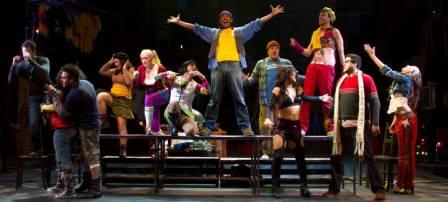
- OCTOBER 2013.
- THE 39 STEPS.
- Playwrights: Adapted by Patrick Barlow from the novel by John Buchan, the movie by Alfred Hitchcock and an original concept by Nobby Dimon and Simon Corble.
- Director: Matthew Wiener.
- Cast: Toby Yatso, Pasha Yamotahari, Michael Kary, Angelica Howland.
- Reviews: Kerry Lengel, Arizona Republic HERE.
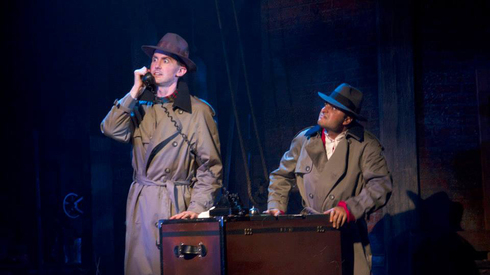

2012-2013 SEASON (In Progress)
- MAY 2013
- OUR TOWN
- Playwright: Thornton Wilder
- Broadway Premiere: 1938.
- Director: Pasha Yamotahari.
- Cast: Joseph Kremer, Maria Amorocho Weisbrod, Allison Houston, Shari Watts, Robert Anthony Peters, Jenny Hintze Barber, Dion Johnson, Debby Rosenthal, Andy Cahoon, David Vining and Alan Ruch
There are American plays and there are classic American plays. Our Town camps out solidly in the latter neighborhood. Beginning in lyricism and ending in tragedy, it is a nostalgic rendering of an America that never was, yet exists in the hearts of many citizens – especially Wilder’s. Unfortunately, Our Town has been done to death by community theaters, colleges and high schools, leading many people to think “Oh, no, not another production of that old thing.” But Wilder’s characters, while seemingly simple, are complex creations and difficult to create believably on the stage. It takes a professional production like this to reveal both the humanism and the nostalgic fantasies that underlie the script.
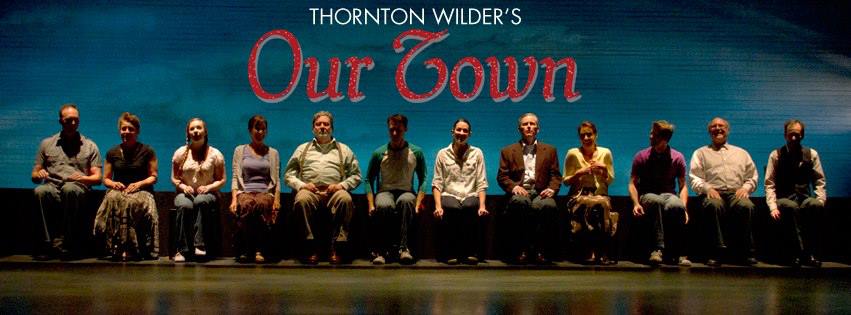
For Kerry Lengel’s review in the Arizona Republic, go HERE
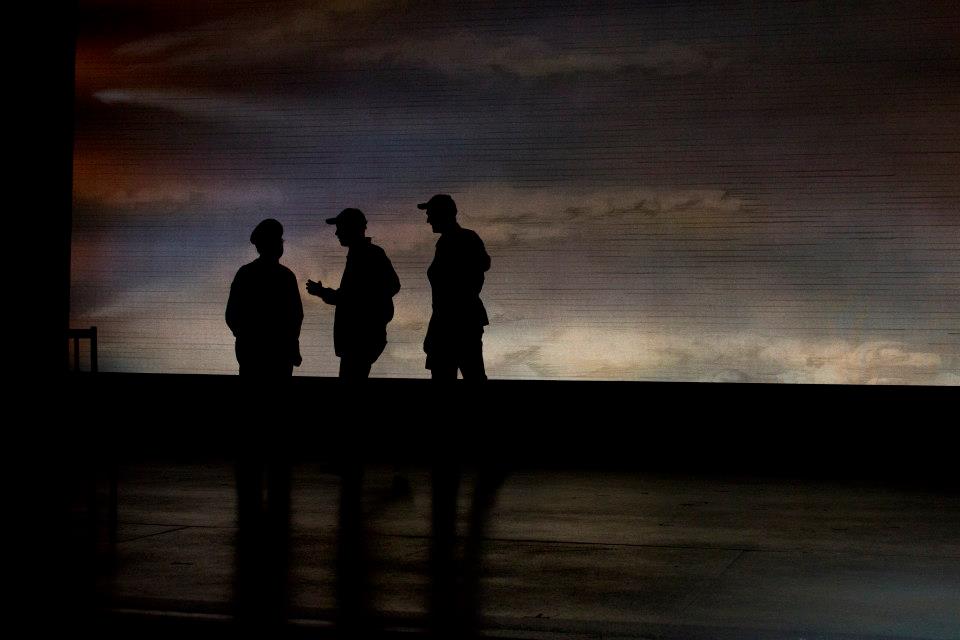
*****
- JANUARY 2013
- S’WONDERFUL
- Music: George & Ira Gershwin.
- Director-Choreographer: Robert Kolby Harper.
- Music Director: Alan Ruchs.
- Cast: Toby Yatso, Kaitlynn Kleinman Bluth, Jenny Hintze, Kyle Erickson Hewitt and Jenn Taber.
- Lighting Design: Michael Eddy.
- Sound Design: Carey Wong.
- Costume Design: CeCe Sickler.
- Comments: Forty-two Gershwin song numbers, almost as many costume changes for the cast. If you’re going to do a musical revue, this is the way. By my count, there are three musical geniuses in town: Michael Barnard, David Ira Goldstein and Robert Kolby Harper. Back when Robert was primarily an actor, who knew? It was PT and Barnard that exposed the Valley to the gifted director-choreographer that lived inside. But what is a director without a cast? Toby Yatso, Jenny Hintz, Jen Taber, Kaitlynn Kleinman Bluth, Kyle Erickson Hewitt. Let me coin a comment: OMG!!

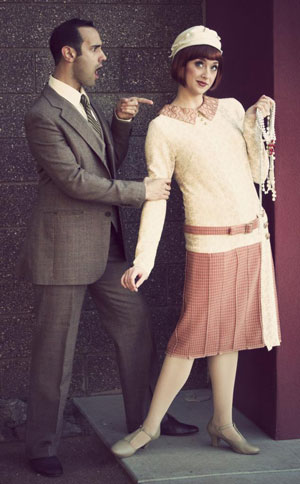
For Lynn Trimble’s review, go HERE
*****
2013 BLOODY BLOODY ANDREW JACKSON
Playwrights: Alex Timbers, Michael Friedman. Director: Ron May. Cast: Caleb Reese, Joseph Kremer.
The following article by Katrina Becker appeared in the June 26, 2013 in the Downtown Phoenix Journal.
Theater-goers looking for fresh repertoire sated their hunger earlier this month with a daring, historically-based production justifiably billed as “sexy-pants.” Phoenix Theatre pushed beyond its standard line-up of expertly-staged Broadway musicals to offer Bloody Bloody Andrew Jackson, giving audiences a sample of the provocative works planned for the troupe’s new black box venue in the coming season.
In the fledgling years of the United States of America, the hot-tempered and fiercely patriotic Andrew Jackson rose from obscurity to become the seventh President, following John Quincy Adams and preceding Martin Van Buren. Along the way, Jackson’s controversial path included defeating the British as a general in the War of 1812, serving as first governor of Florida, fighting accusations of an adulterous relationship with his own wife, establishing the Democratic Party, defending his contentious policies leading to the forced relocation of Native Americans and representing Tennessee in Congress.
Impressively, he was also beloved by the American public, winning the popular vote. Jackson was elected by a tremendous margin in 1828, but his victory in the Presidential race was overshadowed by the death of his beloved wife Rachel.
Jackson’s action-packed life story is fascinating, but is it the stuff of theater? Phoenix Theatre took a well-justified, successful gamble with its run of Bloody Bloody Andrew Jackson performances, which ended June 23. “This isn’t an encyclopedic account of Jackson’s life,” said director Ron May. “You’re not getting a stage version of a Wikipedia page. There are a handful of blatant anachronisms cozied up right next to historical fact,” he continued. “But for the most part what happened, what he did, is dead-on.”
May has made his name in the Valley theater scene both as an actor in shows like Nearly Naked Theatre’s Fuddy Meers – including ovation-winning scenes with a sock puppet — and as Stray Cat Theatre’s founding Artistic Director, offering works like The Dianalogues, columbinus, and Learn to be Latina. May has also directed for Actors Theatre and Black Theatre Troupe.
Bloody Bloody Andrew Jackson is an emo rock play with music (as opposed to a full-bore musical), peppering action, quirky narrators, and impassioned monologues with “angry young men singing about how unfair life is, and angsting and angsting and angsting” — the very definition of the genre, according to May.
He’s always drawn to the works of Alex Timbers and Michael Friedman, who also wrote Very Merry Unauthorized Children’s Scientology Pageant and Heddatron for their theater troupe Les Freres Corbusier in New York. ‘They have a wicked sense of humor, an enormous awareness of pop culture, and an off-the-wall sense of theatricality,” declared May.
“[Bloody Bloody Andrew Jackson]…does for history what ‘The Daily Show,’ for me, did for daily news — made it accessible, interesting, relevant, and a hell of a lot of fun,” said May. “America at the time was a young nation — kind of prepubescent, still trying to find its footing.” He continued, “Andrew Jackson ultimately becomes its mouthpiece — the best front man you could possibly have for an ‘emo nation.’ ” May added, “The show is like an insane mash-up of Schoolhouse Rock, South Park and a Fall Out Boy concert.”
Actor Joseph Kremer described the play as “like a parallel universe. It’s in the history, but it’s all these modernizations of language…. He [Jackson] says stuff like ‘This sucks!’” (some of the most PG-rated dialogue in the show, which carried provocative “mature audience only” warnings).
At the same time, the piece revealed glimpses of Jackson’s personal and ideological vulnerabilities, bolstered by the pleasantly enjoyable shock of Caleb Reese’s clear, melodic voice in the title role, which pointed to his nine-year run with busy local cover band The Instant Classics.
Kremer played multiple parts in Bloody Bloody Andrew Jackson, including Jackson’s political rival Henry Clay and the Native American statesman Black Fox, who negotiated many of Jackson’s treaties.
“Henry Clay’s just kind of funny, and just like an old, grumpy politician…I would call it ‘My dad in a bad mood on a Sunday morning,’” he said, laughing. “Black Fox is a lot more stoic, and…at the end of the show, very serious.” Kremer concluded, “Black Fox is more me, where Henry Clay is more of a portrayal of a character — let’s put it that way.”
As for using Kremer in the role, May said, “The show was written so that non-Native actors could play the Indians, but…[the] biggie is making sure we represent the Indians in the show in a way that isn’t offensive, doesn’t simmer in stereotype.”
Regarding the production as a whole, Kremer said, “It’s tight jeans, big boots…. When you wear it [the costume]…it’s this eyeliner feeling.” He continued, “I think that’s the big difference — I mean, you could do a show about Andrew Jackson and the 1800s…just based on what’s there…but how fun would it be?”
Kremer said, “I have a 16-year-old daughter…there is no way I could get her to sit…and watch a documentary about Andrew Jackson. It just wouldn’t happen.” He chuckled wryly. “But I could get her to sit in the show and…actually be interested in who he is and what he did and…‘Wait a minute – what did he do? Indians? Why would you do that to people?’”
Kremer started his acting career in Nearly Naked Theatre’s 2002 production of Equus, starring with May in Fuddy Meers and Take Me Out and working under his direction in The Laramie Project and other shows. The actor’s credits include Noises Off, Dead Man’s Cell Phone, Much Ado About Nothing, [sic], and, most recently, Phoenix Theatre’s run of Our Town.
It was a bit of a jump turning from Thornton Wilder to Andrew Jackson, admitted Kremer. “How different is it? Uh, wow… I don’t know how to describe it without some drug reference,” he said with a grin, “because…it’s kind of going from this realm of seriousness…to just this constant thing of laughter…so it’s a very different vibe.”
“Going from drama to comedy…it hits a tightrope, because you come into it still in that dramatic role. It’s difficult, but it’s doable,” continued Kremer. “One of the things we did with Our Town…we took away a little bit of the reverence,” he said. “So once the reverence is gone, going between those two is pretty easy, because they’re [both] shows, they’re just a little different, and you have to just pay attention to what’s in the text, and that’ll guide you into good places.”
*****
2012 “SPAMALOT
Music: John DuPrez, Eric Idle, Neil Innes. Book & Lyrics: Eric Idle, based on the 1975 film, Monty Python and the Holy Grail. Broadway Premiere: 2005. Director: Michael Barnard. Cast: Joseph Cannon, Toby Yatso, Robert Kolby Harper, Kimberly Hamby, Michael Andrako, David Errigo, Eddie Maldonaldo, Jonathan Furedy, CJ Mascarelli, Heth’r Brady, Lauren Devine, Trisha Hart Ditsworth, Maris Fernandes, Tyler J. Gasper, Molly Lajoie Plutnicki, Nathaniel Luis, Logan Mitchell, John Wagner, Evan Tyler. Crew: Pasha Yamotahari (assistant director/resident dramaturg), Alan Ruch (music director), Robert Kolby Harper (choreography), Michael Eddy (lighting designer), Robert Kovach (scenic designer), Dave Temby (sound designer), Tim Hatley (costume designer) and Tim Kauffman (hair and make-up designer).
If you grooved on Monty Python, then this was the musical made in heaven just for you. Silliness taken to the nth degree and performed so far over the top that the cast seemed to be living in the Kuiper Belt. Spot-on direction by Michael Barnard, one of the town’s musical geniuses, and the superb musical direction we’ve come to expect from Alan Ruch. Add Robert Kolby Harper’s choreography, Tim Hatley’s deliciously motley costumes and Mike Eddy’s lighting and you have what Camelot should have been but never was.

*****
- 2012
- SPRING AWAKENING
- Music: Duncan Sheik.
- Book & Lyrics: Steve Slater.
- Co-Production with Nearly Naked Theatre.
- Based on a controversial German play written in 1891.
- Directors: Damon Dering, Robert Kolby Harper.
- Cast: David Weiss, Suze St. John, Matthew Cordon, Cooper Hallstrom, Katrin Murdock, Devon Nickel, Maxx Schau, Cassie Chilton, Lindsey Geroux, Bethany Lorentzen, Alexandra Ncube, Sean Mullaney and Evan Tyler Wilson.
- Show Band: Mark 4Man.
Those are those Phoenix Theatre patrons – mostly older, but including some younger folk with families – who decry the passing of a theater that once produced only G-rated shows. They are referring, of course, to the advent of plays like Avenue Q and Spring Awakening on the PT stage. In truth, Phoenix Theatre has never been that place. Throughout its long history, adult literature of a theatrical nature has been welcomed. PT audiences have seen Tennessee Williams and Edward Albee at their best and pop culture at its worst (who can recall Beach Blanket Babylon without blushing?). Still Spring Awakening was an awakening for many in the stalls. Its frank portrayal of abortion, homosexuality, rape, child abuse and suicide as a group of teenagers learn to cope with their hormones – or not! – was a bit of a shocker even to more open-minded patrons.
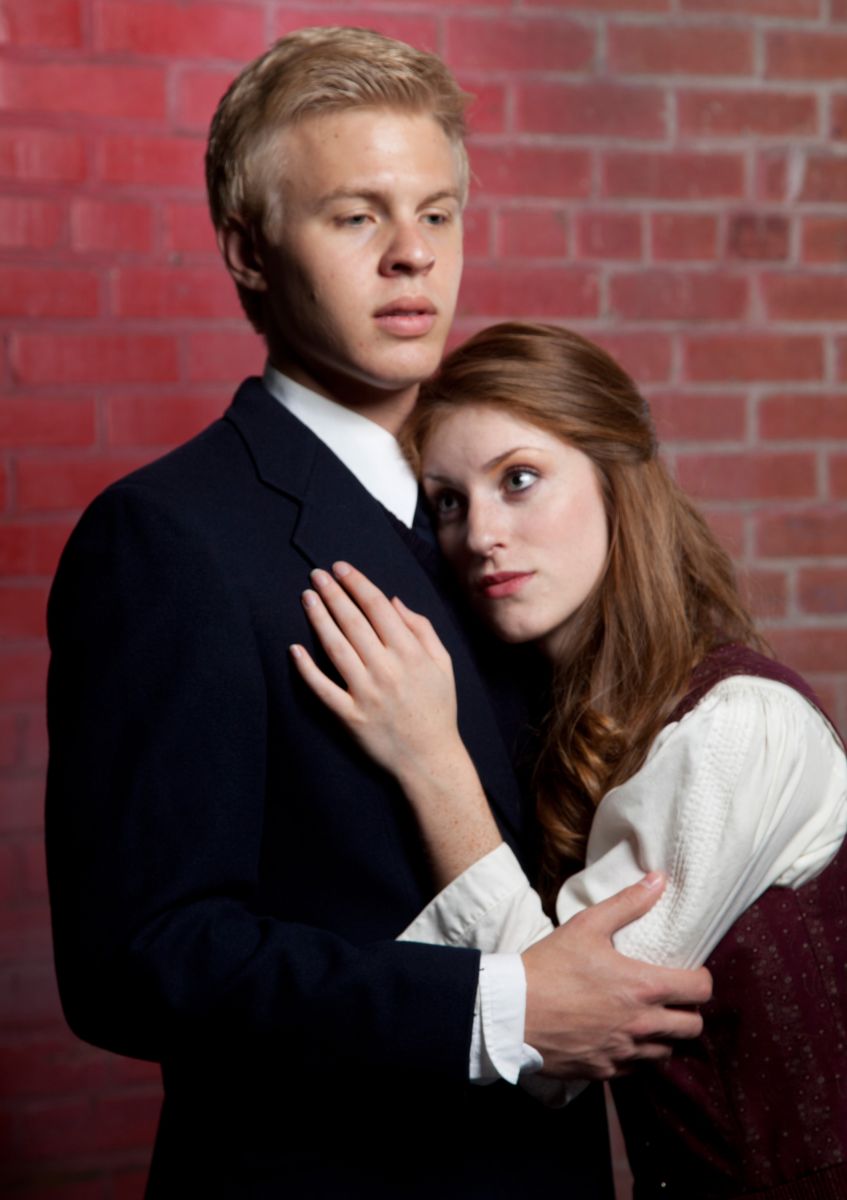
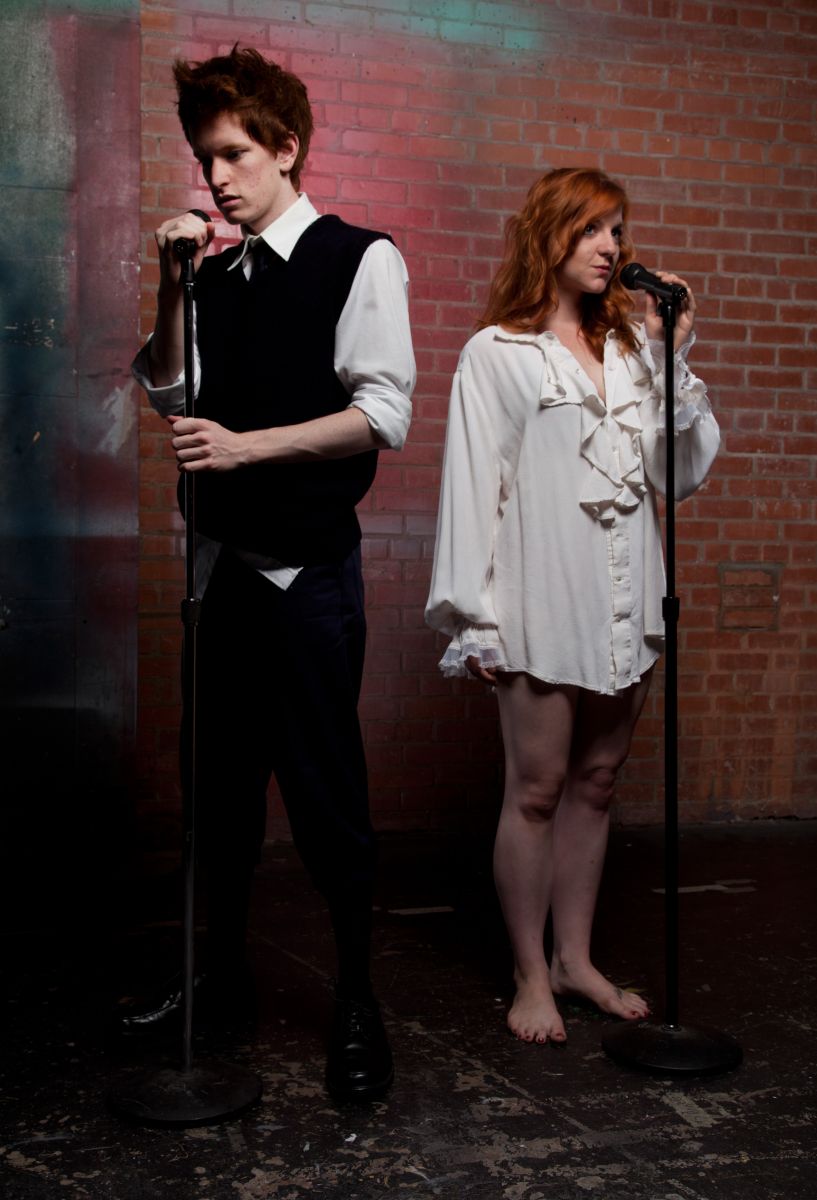
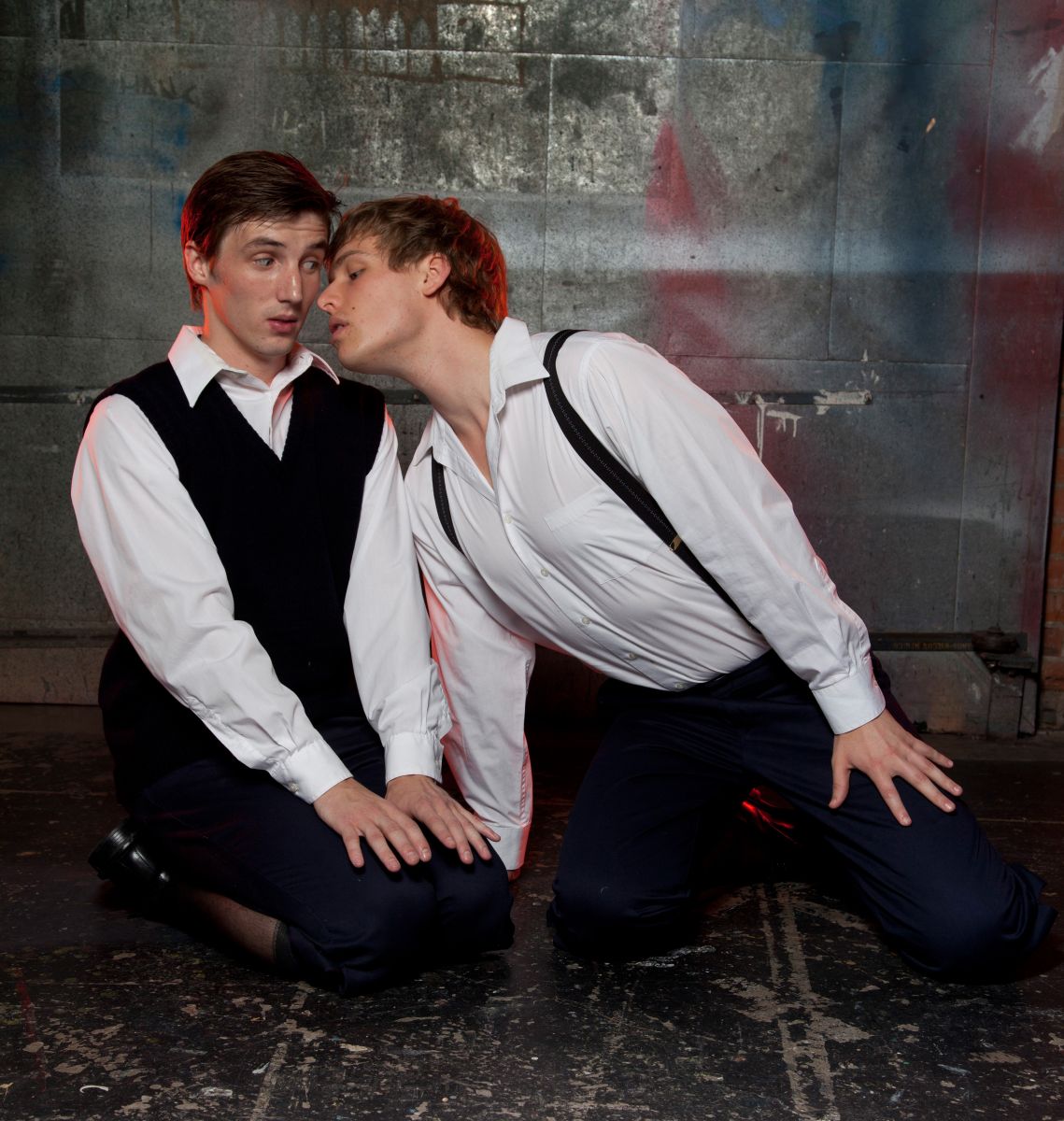
- APRIL-MAY 2011
- NINE
- Music & Lyrics: Maury Yeston.
- Book: Arthur Kopit, based on Federico Fellini’s film, 8 1/2.
Premiere:
- Broadway, 1982, nine years after Yeston’s first draft.
- Director-Choreographer: Michael Barnard.
- Cast: Craig Laurie, Patti Davis Suarez, Jenny Hintze, Johanna Carlisle, Kim Manning, Jeannie Shubitz, Alyssa Chiarello and others.
- Comments: Maury Yeston’s Nine is, in someways, the quintessential musical of the form’s new “adult” phase. It is steamy, wicked, decadent, sly, sensual, raunchy … pick an adjective. What would you expect of a show based on a (pick an adjective) Federico Fellini film? Nine is the story of a movie director who is in full midlife crisis as he turns 40. The title refers to the women in his life and the setting is Venice in the 1960s. PT’s production team made the most of that, you can be sure, with striking scenic, lighting and costume designs. Craig Laurie, an import, took on the challenge of enacting the director, who had been played on stage by Raul Julia and Antonio Banderas and in the film by Daniel Day-Lewis. Some audience members were not impressed. A number of patrons walked out at intermission.
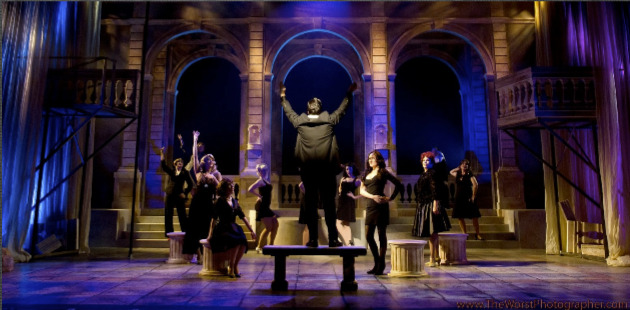
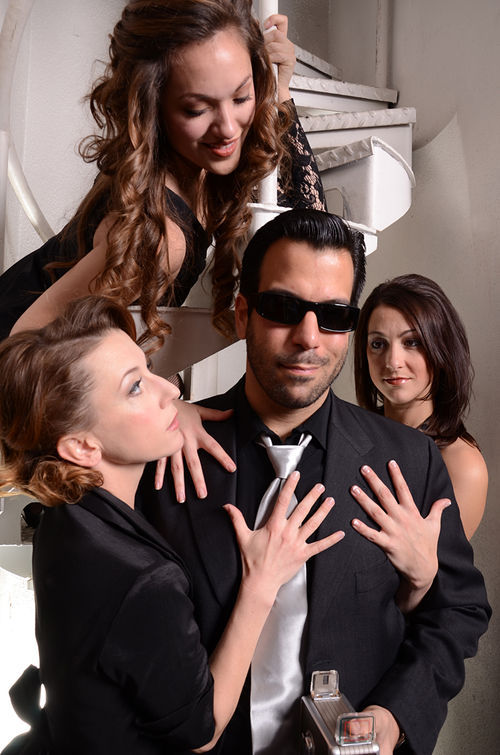
*****
- 2011
- THE SPITFIRE GRILL
- Music: James Valcq.
- Lyrics and Book: James Valcq, Fred Alley; based on the 1966 film.
- Premiere: Off-Broadway, 2001.
- Director: Brad Carroll.
- Cast: Barbara Walker McBain, Toby Yatso, Jeannie Shubitz, Trisha Hart Ditsworth, Rusty Ferracane, Johanna Carlisle.
- Comments: Recently released from prison, Trisha Hart Ditsworth takes up residence in a small Wisconsin town (she liked the autumn colors of a postcard view). She finds work in a grill run by Barbara Walker McBain and attracts the (possibly romantic) attention of sheriff Toby Yatso. When McBain is injured, she turns over the restaurant to Ditsworth, much to the disgust of her nephew, Rusty Ferracane. However, Ditsworth strikes up a friendship with Jennie Shubitz, Ferracane’s wife, that enables her to find some reason to stay in town. As she almost always does, Johanna Carlisle stole the show as a gossipy postmistress. This was an unusual musical to say the least. General consensus? The acting and staging were excellent, the play not so much.
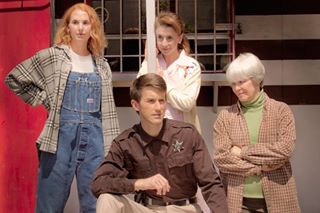

- 2010
- HAIRSPRAY
- Director: Michael Barnard.
- Music Director: Alan Ruch.
- Choreographer: Robert Kolby Harper.
- Cast. D. Scott Withers, Toby Yatso, Dion Johnson, Andi Watson, De Angelus Grisby, Lillian Castillo, Antoyne Le Monte, Shwana Quain, Chase Todd.
- For Kerry Lengel’s review in the Arizona Republic, go

- 2008
- FORBIDDEN BROADWAY
- Director: Roger Castellano.
- Cast: Rusty Ferracane, Lisa Fogel, Sarah Wolter and Toby Yatso.
- Comments: This wacky, wonderful spoof of Broadway’s sacred cows is probably best summed up in this quote from an interview Toby gave to Joseph Gordon of the Gilbert Theater Examiner:(Referring to his devasting mimicry of Harvey Fierstein playing Edna in Hairspray) “In heels and really pouffy hair, I was probably 7′ 4″ by the time you got to the top of my hair.”
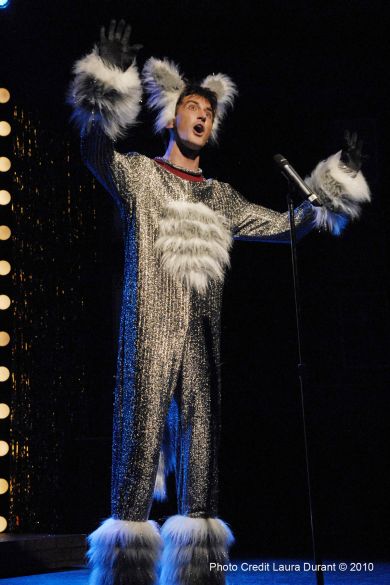
- JANUARY 2007
- LEADING LADIES
- The play premiered at Houston’s Alley Theatre in 2004.
- Playwright: Ken Ludwig.
- Cast: Dion Johnson, Christian Miller.
- Costumes: Gail Wolfenden-Steib.
- Costume Shop Manger: Marjie Bell.
Interview by Kyle Lawson in The Arizona Republic, Jan. 7, 2007
Leading Ladies, the new comedy at Phoenix Theatre, is out to mislead you. Don’t give ’em two cents for that title. Not unless your idea of ladies involves five o’clock shadow and hogging the remote.
Playwright Ken Ludwig is up to his old tricks. Remember Lend Me a Tenor, about an opera singer who wasn’t one? Or Moon Over Buffalo, which featured much ado about a Frank Capra movie that was never made?
This one is about two British actors on their uppers in America who are reduced to doing Shakespeare at the Moose Lodge. They read about an old lady who wants to leave her fortune to two English relatives she has never met. Being of the proper nationality, they sense an opportunity and show up at the door, only to learn that the missing kin aren’t their gender.
Because Leading Ladies is a farce, it’s close door, reopen and enter Maxine and Stephanie, or, at Phoenix Theatre, Dion Johnson and Christian Miller, in their best heels and eyeliner.
“It’s very, very funny,” said Johnson, who has made a habit of
landing in some of the nuttiest roles in local stage.
“It’s set in 1952 and it’s meant to be a bit dated,” he said. “It
could be a show that you saw on Broadway years ago, but with humor you couldn’t have gotten away with then. It’s a stretch for us to get it just right.”
He pauses, then laughs.
“Who am I kidding? I just wanted to put on a dress and heels.”
For Miller, another Valley veteran, it’s the first time onstage in
women’s garb.
“I have a whole new respect for women,” he said. “And it’s not just the accoutrements. It’s been incredible learning to think like a
female, particularly a female in the 1950s. You can’t rely on your
instincts to get you there, it takes a lot more technique.”
How’s he doing?
“I’m not sure I’m a good woman,” he said, chuckling. “Luckily, it’s a comedy.”
Miller may be modest but he’s not above a little bragging.
“I have more shoes than any actress in the play,” he said,
proudly. “I’m getting used to them. The other day I put on a pair of heels and they felt like flats. ‘OK,’ I told myself, ‘that’s good.’ ”
The biggest challenge for Miller has been learning to tango in
stilettos.
“You know what they said about Ginger Rogers? She did everything Fred Astaire did but backward. I’m in touch with that.”
Because the play not only features men and women but men masquerading as women who make split-second changes back into men, Marjie Bell, Phoenix Theatre’s costume-shop manager, has had her needles working overtime creating Gail Wolfenden-Steib’s designs.
Johnson and Miller require Shakespearean costumes, 1950s men’s suits, dinner jackets, evening dresses, day dresses and slacks outfits.
“It’s been interesting,” Bell says. “Dion and Christian are typically
shaped men, with decent chests and not much in the way of backsides. Fortunately, the play calls for chest and arm hair to be seen, so we don’t have to worry about covering that completely – but, at the same time, we don’t want them looking like drag queens. We want the audience to ask itself: Is it possible for these two to fool this old lady?”
One scene requires a rigged tuxedo that allows its wearer to pop off stage and return immediately as a woman – then do it in reverse. But that was not any harder to accomplish than the men’s regular dresses, Bell says.
“The other night, my assistants were home watching movies and making breasts,” she said. “The changes are so fast that each dress has to have its own set. Thankfully, my staff is very skilled at making lentils and fiber look like the real thing.”
The men’s lack of appreciable backsides didn’t trouble Bell much.
“It’s the ’50s and most of the dresses have these big petticoats,”
she said. “That’s good, because you really can’t sew a fanny into a
dress.”
Rehearsing with their bodies sticking out in unexpected directions
and covered in fluffy fabric has created almost as much comedy as the actors’ efforts to bring Ludwig’s script to life, says Brian Kunnari, the theater’s marketing manager.
“My office is next to the rehearsal hall and our stage manager has a very distinctive laugh. I can hear it coming through the walls. If
the show’s as funny as the rehearsals seem to be, we’ve got a hit on our hands.”
What happens, though, when the rehearsals end? Do the actors take their roles home? Miller swears he hasn’t been caught with his hand in his significant other’s lingerie drawer.
“I spend way too much time in the costume shop trying on their
stuff,” he said. “I don’t feel the need for homework.”
- NOVEMBER 2005
- PICNIC
- Year Produced on Broadway: 1953.
- Playwright: William Inge.
- Director: Karla Koskinen.
- Cast: Robyn Allen, Maria Amorocho, Donal Thoms-Capello, Katie Olsen, Erin Singleton, Robert Holt.
- Sets & Lighting: Jim Hunter.
- Costumes: Gail Wolfenden-Steib
REVIEW: Kyle Lawson, The Arizona Republic, Nov. 13, 2005
There’s a deep divide between sex and love. Some lower a plank across it and get on with things. Others never make it from one side to the other.
William Inge’s Picnic , now onstage at Phoenix Theatre, is full of characters who want to be loved but haven’t figured out how to span the gulf. Most have resigned themselves to a generic equivalent, feeling only remotely like the genuine article but better than nothing.
Enter a drifter, young, not too bright but bursting his jeans with raw sexuality. In short order, everyone is back at the brink, contemplating the distance across.
If Inge has any poetry in him, it’s the voice of the unrequited and those who make the most of second best. No one walks away unscathed in his plays, and certainly not in Picnic . Sex may serve the characters as a tool and an escape but its potential as a bridge builder is flimsy at best.
For this small-town soap opera to work, it needs a drifter who’s as charismatic as he is rough about the edges, as sensual as he is muscle-bound, as dangerous as he is irresistible. Unfortunately, Donal Thoms-Capello doesn’t measure up.
He’s a beauty, no doubt of that. Not a bad actor, either. But his drifter is a big, overgrown boy, romping among the play’s womenfolk like a puppy wanting to be liked, not the elemental force of nature that will send their lives careening on a new course.
Happily, the rest of the cast is up to Inge’s requirements, particularly Katie Olsen as a young woman torn between the man everyone believes is right for her and the one she wants for herself. Erin Singleton and Robert Holt give good accounts of themselves as a girl on the verge of womanhood and a spinster schoolteacher’s reluctant beau. Robyn Allen and Maria Amorocho deliver their usual finely turned performances as a single mother doing her best and the schoolmarm.
Director Karla Koskinen paces the play’s three acts quickly but never loses her grip on the story. Scenic and lighting designer Jim Hunter captures the Midwestern setting perfectly, and Gail Wolfenden-Steib’s ’50s clothing proves she is the Valley’s costume designer without peer.
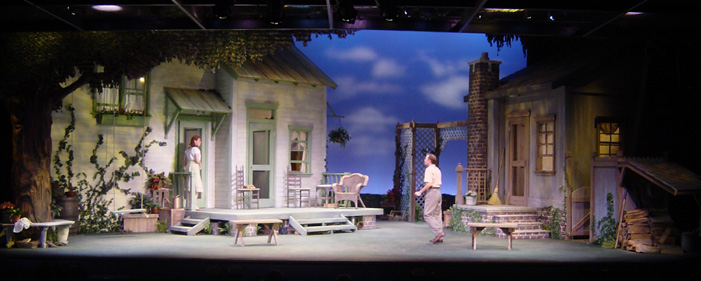
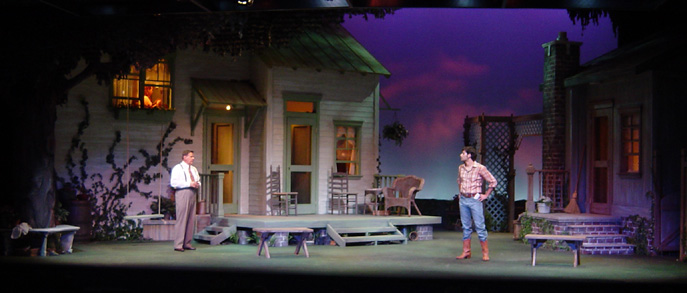
*****
- 2001
- “STEEL MAGNOLIAS”
- Playwright: Robert Harling.
- Director: Bob Sorenson.
- Cast: Linda DeArmond, Patti Davis-Suarez, Carolyn Pain, Heidi Ewart, Trish Kiser, Katherine Stewart.
Kyle Lawson reviews the production:
Age has dealt kindly with Steel Magnolias.
At its 1987 premiere, Robert Harling’s female-bonding comedy was greeted with hoots of derision from some quarters. Too sentimental, its detractors cried. Too many one-liners reminiscent of Neil Simon. Too many weird characters.
Phoenix Theatre’s revival, craftily directed by Bob Sorenson, refutes those claims. Sentimental? Yes, this tale of six women who meet regularly at a Louisiana beauty parlor, is that — but any tendency to schmaltz is undercut by Harling’s humor, as sassy as it is sometimes painfully honest.
We’ll grant the naysayers this: The characters are weird.
Crazily, wonderfully weird.
Truvy (Heidi Ewart), the fashion-challenged beauty-shop owner, has big hair and a bigger heart. Her assistant, Annelle (Trish Kiser), is an abused wife turned born-again Christian.
The “regulars” include Clairee (Patty Davis-Suarez), a recent widow who’s football crazy; Ouiser (Carolyn Pain), a cantankerous dog owner; M’Lynn (Linda DeArmond), an obsessive mother (with good reason, as it turns out); and Shelby (Katherine Stewart), M’Lynn’s daughter, who, as the play opens, is preparing to hitch up to a good ol’ boy just like the gun nut who married Mom.
The women gossip, cheerfully trade insults and gather round to support each other in times of triumph and tragedy. There are weddings, births, out-of-the-closet nephews, unexpected deaths and the constant war between Ouiser and M’Lynn’s husband, Drum, to keep them busy.
In creating these characters, Harling has deftly trod the line between soap opera and bitch fest. His portraits, though sympathetic, are multidimensional; sessions at Truvy’s reveal the flaws beneath the carefully applied cosmetics.
Although it would be easy to assume that many have seen the play or the all-star movie (Dolly Parton, Daryl Hannah, Olympia Dukakis, Shirley MacLaine, Sally Field and Julia Roberts in the respective roles listed above), it was clear that some in Sunday’s audience had not.
Therefore, the plot won’t be given away here. One of Truvy’s lines is offered in its place: “Laughter through tears is my favorite emotion.” It sums up the play nicely.
The Phoenix cast members are as all-star as the movie’s crew, even if their accents aren’t quite as good. The emotions, though, and the comic timing — those the local actresses nail almost perfectly.
The closing moments of the play — when M’Lynn’s frustrations get the better of her grief, leading to a confrontation between Clairee and Ouiser — is so wrenching, so funny, that any sensible theatergoer would pay to see it if nothing else.
If proof were ever needed that DeArmond, Davis-Suarez and Pain are actresses worthy of any stage in the world, here it is.
*****
- MARCH 2000
- “SIX DEGREES OF SEPARATION”
- Playwright: John Guare.
- Director: Gary Griffin.
- Cast: Linda DeArmond, Bruce Nelson, Harold Dixon, Laura Durant, Mel Reid, Tim Shawver, Kyle Sorrell, Andrea Morales, Michael Sherwin, Jeffrey C. Hawkins, Damon J. Bolling (see below).
- Note from Tim Shawver: Damon J. Bolling took over the lead when the original gentleman quit. It is how Damon got his Equity card, an Equity contract role can’t be replaced with a non-Equity actor. So PT made Damon Equity. He did more performances than the initial actor.
- More from Tim: Vincent Van Vleet, current Managing Director of Phoenix Theatre, was the stage manager of that production. It was Vincent’s first association with PT. Gary Griffin was a Chicago-based director and brought Vincent with him as his favorite stage manager.

Kyle Lawson reviews the production:
Six Degrees of Separation is not only the best thing Phoenix Theatre has done in years, it is a wake-up call most Americans are reluctant to answer. There are no secrets left. Everything is out there waiting to be discovered if someone is willing to make the effort and Paul, a gay hustler with upwardly mobile ambitions, is that someone in John Guare’s disturbing comedy.
Through a chance encounter with a john, Paul obtains inside information on a number of wealthy New Yorkers. He uses the knowledge to worm his way into these people’s homes, conning them into believing he is actor Sidney Poitier’s son.
Paul’s impact is by turns wickedly funny and devastating, particularly on the lives of Ouisa and Flan, a pair of art dealers who somehow have become disconnected from everything but their pretensions.
Best known for his anti-Establishment comedy, House of Blue Leaves, Guare demolishes any delusions of privacy that persist in the Internet Age, while taking jabs at everything from America’s obsession with celebrities to Generation X angst.
The laughter is saturated with irony. Though the script famously posits that we are all connected – the “Six Degrees of Kevin Bacon” game originated here – Ouisa and Flan are enigmas to their children and friends, and vice versa.
Gary Griffin directs Guare’s provocative material at a staccato pace, underlining the characters’ sense that things are out of control. If Bruce Nelson’s Paul is less than charismatic, Linda DeArmond and Harold Dixon deliver flawless performances as the art dealers, backed by a solid supporting cast.
For years, Phoenix Theatre has wasted energy on worn-out musicals and comedies. Audiences have dwindled to the point that the state’s oldest theater is one of its most at-risk.
Six Degrees proves that the 80-year-old troupe can set the standard for must-see theater. Its future depends on whether it makes it a habit.
For Robrt Pela’s review in the New Times, go HERE
Here is Kyle Lawson’s interview with “Six Degrees” star, Bruce Nelson:
For Will Smith, playing a gay guy in the film version of Six Degrees of Separation was one thing. Getting nude and getting it on with another man was something else.
When the movie’s producers told Smith they wanted to include a sex scene involving his character in the buff and a male hustler, the young actor hit the D button.
As in Denzel.
Smith asked Washington what he should do. Washington replied that if he were Smith, he’d watch out for his backside, not let the whole world do it.
Unfortunately, Denzel Washington’s number isn’t in Bruce Nelson’s Rolodex. Even if it were, it wouldn’t get used. The Valley actor isn’t concerned about stepping into Smith’s role in the Phoenix Theatre production of Six Degrees.
“I’m coming from a completely different place,” he says. “Film is forever. People can make clips, it ends up on the Internet and you don’t have any control on how the image is used.
“Before he did the movie, Will Smith had established himself as a kind of fun, silly, very likable character. Sure, if I were in that situation, I’d think about how far I should go.”
Nelson isn’t.
“As a stage actor, I’ve done all sorts of roles,” he says. “In Dear
Esther at the Herberger, I was a Nazi, a rabbi, a Jewish capo — a gay guy who cons his way into a house pretending to be Sidney Poitier’s son isn’t too far of a stretch.
“Anyway, I think theater audiences are pretty open to seeing actors try different things. They’re not as likely to typecast them.”
One of Smith’s concerns was whether indulging in public sex was a good image for an African-American actor.
“A lot of people seem to want to make that the issue, but for me, it’s always about finding the truth of the work,” Nelson says. “I’m playing a character; that’s not me. I don’t know about film audiences, but theater audiences seem to understand that. In any case, to say that this play is about sex is like saying Moby Dick is about a whale. It involves the audience on so many levels.
“I want to do things that stretch me emotionally, psychologically and in terms of my talent. That’s never going to happen if I don’t take risks.”
An article by Kyle Lawson in the March 19, 2000 Arizona Republic.
Frontal nudity is a rare commodity on Valley stages. Even Planet Earth Theatre, the most adventuresome of the Valley troupes, is reluctant to expose anything more than its actors’ buttocks — although it has, on occasion, asked actresses to bare their breasts.
That makes it all the more surprising to find a character facing his audience in the altogether at Phoenix Theatre, long a bastion of mainstream theater. The glimpse is brief and is an essential part of the plot of John Guare’s Six Degrees of Separation, a dark comedy about a man who claims to be Sidney Poitier’s son and who uses that connection to invade the home of a cultured couple who pride themselves on their broad-mindedness.
The man is a conniving opportunist, the nude character is a male prostitute and the nudity (lasting perhaps 5 seconds) is a shocking revelation to the wife, who realizes for the first time that she has put her family at risk in inviting this stranger into her home.
“It enables the audience to share her sense of horror and her feeling that her secure, sheltered world has been invaded — that she has, in a sense, been violated,” says Michael Barnard, Phoenix Theatre’s producing artistic director.
The Guare comedy isn’t the first time a mainstream Valley theater has featured male frontal nudity. Several seasons ago, Arizona Theatre Company staged M Butterfly, whose plot turns on a scene in which the play’s “heroine” disrobes and reveals indisputable proof of manhood.
Without that moment of truth, M Butterfly wouldn’t have worked, says David Ira Goldstein, ATC’s artistic director. The company’s audiences understood and took it in stride.
“It doesn’t matter if it’s nudity or language,” Goldstein says. “If it’s essential, audiences will accept it as part of the artistic experience. But if it’s gratuitous — if you’re taking the actor’s clothes off for the hell of it — then they won’t accept it, and they shouldn’t.”
Barnard is banking on that reaction. “This isn’t the sort of thing you see regularly at our theater, but I’m hopeful our subscribers will accept it in the context of the work,” he says.
In truth, Six Degrees, which has never been professionally staged in Phoenix, is more famous for the “Six Degrees of Kevin Bacon” game it inspired than for its frontal nudity, Barnard says.
Guare took his central conceit from studies by Harvard’s Stanley Milgram that suggest everyone in the world is connected through a chain of at most six acquaintances.
In the Internet age, that has become six clicks or less, Barnard claims.
“Guare deals with the question: Just how private is our privacy?” he says. “In the play, the young man claiming to be Poitier’s son knows someone who knows the couple’s children — and that allows him to forge a connection that gets him into their home.
“I think most people would be horrified to learn just how much total strangers know about them.”
That theme — and the play’s look at America’s obsession with celebrities and the way celebrity status is abused — make it about considerably more than its brief nude scene, Barnard says.
“We talked a lot before going ahead with this,” he says. “We didn’t want the play to be judged on 5 seconds of nudity, but we also realized those 5 seconds put the story into overdrive.
“To counteract that, we’re making a point of letting people know what to expect. We don’t want anyone coming to the theater and saying, ‘You didn’t tell us.’ ”
WHITHER PHOENIX THEATRE NOW?
With the 1999 departure of both its managing director Michael Mitchell and its managing director Denise Ford, Phoenix Theatre was pitched into another of its periodic crises. Kyle Lawson wrote this article for the March 16, 1999 issue the Arizona Republic:
Sometimes the dots connect themselves in unexpected ways.
The event was last week’s annual 10-minute-play competition sponsored by Writer’s Circle and Actors Theatre of Phoenix. The venue was the Herberger Theater Center. My body was there, one eye on the stage, one ear on the scripts, but my mind was on Phoenix Theatre.
Bear with me for a minute.
At 79 years and counting, Phoenix Theatre is the state’s oldest theatrical institution. No other company even comes close. But the troupe has gone through unsettled times. It has suffered a drastic decrease in subscribers, financial calamities and a loss of artistic identity.
Around it, the city it has served (and often brilliantly) for so many years has reinvented itself. Every car that arrives from out of state, every plane, every bus brings in new residents for whom history begins the day they arrive.
Traditions – even 79 years of them – don’t mean much.
Six years ago, with the arrival of artistic director Michael Mitchell, and later the addition of managing director Denise Ford, things began to change.
The decline in attendance was reversed, the company’s financial health restored and strides made in terms of production values and artistic quality.
Yet Phoenix Theatre was unable to reclaim its position as Phoenix’s theater.
That title had been usurped by the newcomers – Arizona Theatre Company, Actors Theatre of Phoenix, a revitalized Valley Broadway series at Gammage Auditorium, the restored Orpheum Theatre and a host of smaller troupes.
Unfairly, perhaps, but no less devastating for that, Phoenix Theatre was stigmatized as a repository of ancient comedies, hoary dramas and musicals that had been seen too many times. True, those things still had a place on the playbill, but they were accompanied by some daring choices in programming for which, by and large, Mitchell and Ford never received the credit that should have been their due.
Now Mitchell and Ford have resigned. The board of directors is in the midst of a search for their replacements. It is a chance, perhaps the last chance given the presence of so many competing theaters, for the company to regain its place in the Valley of the Sun.
That brings me back to that night at the Herberger, watching those 10-minute plays.
Those newcomer companies have brought us excellent theater; they have hired local performers, technicians and, occasionally, directors. On far fewer occasions, they have taken a chance on local playwrights.
There were seven writers represented at the Herberger presentation: Howard Allen, Trista Baldwin, Linda DeArmond, Gus Edwards, Wendy Myers, Guillermo Reyes and Elaine Romero, Arizona residents all, at least for now. Several of that group have had a play produced locally, but only at the smallest theaters and seldom with the resources to do the work justice.
Let’s dream a little. Suppose that whomever the Phoenix Theatre board chooses to lead the company into the new millennium has a passion for nurturing young writers. That that new person will make the company’s pair of stages available to local writers and not just to famous writers (alive or dead) or writers whose work has been produced elsewhere. That that person will commit the company’s considerable resources to this new work.
Imagine what we might see. Imagine what gifts we might give to the larger theater community in terms of new scripts, new visions, new artists.
Pretty exciting, isn’t it?
Writers weren’t the only ones on display at the Herberger that night. Directors and actors played their part in bringing those playlets to life. To be honest, sometimes they were better than their material. If there was a common denominator, it was that only a handful of them, again, ever work outside the very smallest companies.
A director as talented as Matthew Mazuroski should be working at the top. Actresses as charismatic and skilled as Maria Amorocho and Janice Robillard should be seen more than once a year – if that. The actors from the Childsplay ensemble (in this case Debra K. Stevens and Jon Gentry) again proved that the only word for them is awesome – and that, good as they are in children’s theater, they are meant for adult things. (If Gentry is not our most gifted physical clown, it’s only because Bob Sorenson keeps trying to grab the title from him.)
How wonderful it would be if the new person at Phoenix Theatre would find room for these folks as well as those writers. Give them a chance to use those acting and directing muscles on a regular basis, and who knows what we’d see.
Something great, I suspect.
Arizona Theatre Company and Actors Theatre of Phoenix are doing their part, though perhaps not as much as they could. But two companies can’t support a talent pool, or a stable of writers. We need a third company, with two stages, with resources, with a multiplay season, to fill the gap.
It may be tempting to the board to hire someone from out of state, someone with a “reputation.” If that happens, that person will rely, at least for a while, on talent from wherever that person comes. That would be a shame. There is talent here. Now. Will Phoenix Theatre make use of it to once again become Phoenix’s theater?
We can dream.
- APRIL 1999
- “WHO’S AFRAID OF VIRGINIA WOOLF?”
- Playwright: Edward Albee.
- Director: Gary Griffin.
- Cast: Wendy Robie, Kim Bennett. Matthew Mazuroski, Holly Hunts.
- Scenic Design: Gro Johre.
- Lighting Design: Paul Black.
- Note from Laura Durant: I understudied both female roles for that show – and Gary couldn’t resist pranking me one night. “Did you get the message? You’re going to have to go on for one of the roles.” He kept sipping his coffee to hide his snicker as I went into deer in the headlights mode.
Kyle Lawson’s review appeared in the April 14, 1999 Arizona Republic.
Audiences live in fear of Edward Albee. Not only because his plays are challenging but because most theater companies make a mess of them.
Everyone can rest easy with Phoenix Theatre’s revival of Who’s Afraid of Virginia Woolf? Director Gary Griffin, a fine cast led by Wendie Robie of Twin Peaks fame, and a team of the Valley’s A-list designers have gone straight to the core of Albee’s searing masterpiece about a married couple and the desperate games they play to keep their relationship alive.
Griffin orchestrates the piece like a mad railway engineer bent on setting a new record for speed, yet he periodically and perversely slams on the emergency brakes, hurtling the audience out of its seats.
The actors, attuned to Griffin’s diabolical rhythms and, better yet, capable of pulling off the emotional careenings, makes, on the whole, brilliant work of this harshly poetic descent into the dark netherworld of human relationships. The result is explosive and frightening and funny and, even if not perfect, the best Albee that local theater has produced in years.
Written in 1962 and denied the Pulitzer Prize because of its profanity and general corrosiveness, Virginia Woolf defies dating. The story of George, a history professor yoked to the alcoholic Martha, who is 6 years older, richer and the college president’s daughter, crackles with contemporary urgency in its examination of the hypocrisy and outright lies that form the fragile underpinnings of many marriages.
Its look at the sexual and political mores of academia also rings true. Life moves on, Albee observes gloomily, but the sad verities never change.
Gro Johre’s expansive, richly detailed set, enhanced by Paul Black’s moody lighting, serves the action symbolically as well as physically. Its somber tones are emboldened by touches of ruby, even as George and Martha’s increasingly moribund union is enlivened by bursts of rancorous venom. The steeply raked stage, built on a diagonal that extends into the auditorium, pitches the drama into the laps of playgoers. There is no escape.
And there are no prisoners taken in Robie’s performance, which stalks the edge of that rake like a panther in heat, sexually aggressive, almost psychotic in the intensity of her reactions to George. Robie plunges fearlessly into that no woman’s land where a wife loathes her husband as much as she adores and idolizes him. Robie’s Martha seeks to unman George at every opportunity but yet . . .
This is the actress’ first attempt at the character, arguably one of the greatest parts for a female in the American canon. It is impossible to get it all on first try, and Robie doesn’t quite manage the tragic dimensions of the role. Yet she powerfully depicts Martha’s frustration with George: that he is not the man her father is; that he is not the husband she wants him to be; and, most of all, that he is not the man he wants to be. She punishes him out of a terrible love: He has failed himself, and she cannot forgive him for that.
Kim Bennett, on the other hand, is all that George can and should be. He is a husband in extremity, close to the breaking point yet incapable of resisting the vicious power games that his wife plays. He is determined to one-up her, but he is moved by an equally terrifying love. He knows the games must end, and so he ends them, in a scene that is as chilling and cathartic as it gets in theater.
As the lights fade, the couple’s one point of connection has been severed, but they are in each other’s arms. That’s as much of a happy ending as one can expect of life, the playwright says.
Casting the leading performances into greater relief are excellent supporting turns by Matthew Mazuroski and Maggie Hunts as Nick and Honey, the ambitious biology professor and his naive wife who are drawn against their will into George and Martha’s evening of fun and games. They, too, have painful secrets that the older couple pick at like scabs, and Mazuroski and Hunts make perfect foils for the play’s scathing humor.
Phoenix Theatre is to be congratulated for producing such a difficult, harrowing piece and praised for doing it so well. Long the also-ran among the city’s major troupes, it has thrown down the gauntlet with this one. Other companies will do well to come close, much less match it.
For Robrt Pela’s review in the New Times, go HERE
Kyle Lawson’s interview with Wendy Robie appeared in the April 11, 1999 Arizona Republic.
Wendy Robie should always sit in the sun.
The shaft of light coming through the restaurant window pools around her, transforming the coppery hair into an inferno and imparting a translucent, rose-like sheen to the smooth complexion. The eyes, by contrast, are plunged into shadow. Already dark, they are reservoirs of mystery.
Every actress should look like this: glamorous, enigmatic, elusive, dangerous.
Dare one offer a penny for this creature’s thoughts? It might be a costly proposition. The reporter writes the word “pensive” in his notebook, then underscores it as Robie abstractly rearranges the Chinese vegetables on her plate.
The expressive features, honed by the sort of cheekbones mothers want for their daughters, search some inner landscape. A penny? A mirror, maybe, to see what she’s thinking.
Robie is not normally so reserved. A kind of drawn-out, cascading laugh and a generous personality endear her to her friends. At the moment, however, she is caught up in contemplating the role of Martha, which she is playing at Phoenix Theatre.
Martha is the festering, tortured woman at the heart of Edward Albee’s scathing comedy, Who’s Afraid of Virginia Woolf? To attempt the role scares any sane actress. To step into it on short notice as Robie has done borders on insanity.
“Not enough time,” she says, then repeats the thought, turning it into a mantra. “Not enough time. Not enough time.”
Suddenly, a smile breaks across her face. Like any good actress, she can warp moods faster than the Enterprise can shift galaxies.
“Enough of this,” she says, showing off that laugh. “I know I’m lucky to get the chance, and I intend to make the most of it. Gary (Griffin, the director) is going against type here. In the script, Martha is a big woman, a blowsy woman, Colleen Dewhurst! But here I am, and even though it’s terrifying to be doing this amazing piece of theater, I couldn’t be in better hands. If I fall on my face, it’s my own fault.”
Kim Bennett, who’s playing George, Martha’s husband, suggested her for the part. Years ago, the two worked in Seattle theater. They kept in touch and, as actors do, fantasized about a rematch on stage. When the role of Martha went begging, Bennett gave her name to Griffin.
“But it was Kim who called me at my home in California and said, ‘I’ve got it, the perfect part. Martha in Virginia Woolf!,” Robie says, half in laughter, half in lingering amazement. “I thought it was a joke. But it wasn’t.”
No blame to her that she’s nervous. Virginia Woolf is one of those pieces that separates the actors from the people who like to play “let’s pretend.” Not only is the script difficult to perform, its tale of George and Martha, trapped in the marriage from hell, and Nick and Honey, the pawns in the nightmarishly funny games George and Martha play to get at the truth, has set audiences and critics on their ear since its premiere in October 1962.
The stories are legend and most of them true. Albee took the title of the play from a scrawl he noticed on the men’s room wall of a Greenwich Village bar. He wanted to use the song, Who’s Afraid of the Big Bad Wolf?, as the play’s theme music, but the copyright owner refused permission, and Albee supplanted it with Here We Go ‘Round the Mulberry Bush.
It wasn’t the first substitution. In Boston, the censors were offended by the phrase, “Jesus H. Christ,” which is among the first things uttered on stage. Rather than go to the mat on the issue, Albee changed the dialogue to “Mary H. Magdalen.”
Virginia Woolf won most of the accolades its debut year, including the Tony and Drama Critic’s awards. It did not win the Pulitzer. The Columbia University advisory board in charge of the country’s most prestigious literary prize overruled the decision of its jurors and withheld the citation for drama, only the sixth time that had happened since the Pulitzer’s founding in 1917. Two jurors, John Mason Brown and John Gassner, resigned in protest.
It’s a considerable heritage, and the part of Martha lives up to it, Robie says.
“I truly believe this is the greatest role ever written for a woman,” she says. “I have played Lady Macbeth twice and, believe me, Martha puts her in the shade! The emotions are as elemental as anything in the Greeks.”
Martha lives “in a firestorm of rage,” Robie says, “but you must never lose sight of the fact that, in the midst of that conflagration, she loves her husband. Martha will punish George forever for not rescuing her from herself but, in the end, she knows, as he does, that their story is a love story – a great and terrible love story.”
Rehearsals have been their own kind of firestorm, frightening, daunting, exciting. Robie admits nothing in her experience really prepared her for Martha, even though she has played her share of “psycho broads.”
She is best known, perhaps, for her role of Nadine, the crazy lady with the eye-patch in David Lynch’s cult TV series, Twin Peaks, and as the sadistic landlady of Wes Craven’s horror film, The People Under the Stairs.
But, on the whole, her roles have been gentler, kinder, the Violas and Julias of Shakespeare, the heroine’s best friend in Wendy Wasserstein’s The Heidi Chronicles.
“This thing just rips you up,” she says. “It asks everything of you and, in return, breaks your heart. That’s why I’m so glad I have Gary and Kim as my support. I am going to some very dark places and they create a safe place to do that. Their support means that I can come back again.”
Again that laugh. In addition to giving her confidence, the men are her reality check, she says, a hedge against those moments when she is tempted to plunge into the depths of melodrama.
“Martha brings you to the very edge,” she says. “And that’s scary because, out there, you can fall off at any time. Having someone say, ‘That’s too much, that’s too far,’ is paramount, of the utmost importance. Otherwise, it’s the sound of one hand clapping, one voice shrieking.”
- ON THE SUBJECT OF RESTROOMS.
- Article by Kyle Lawson, The Phoenix Gazette, Oct. 1, 1995
A group of men have sneaked into the women’s restroom at the newly refurbished Phoenix Theatre. They’re clearly awed by the experience.
“Is this or is this not the Versailles of women’s bathrooms?!” crows Michael Mitchell, the theater’s executive director.
The room is pretty spiffy, even if it lacks the marble and crystal implied by Mitchell’s description. It has something far more important: nine stalls.
Before the theater’s $3.5 million remodeling project, the bathroom had two — and as many as 100 women anxiously lined up to use them during a 15-minute intermission.
“Is it any wonder people ran out before the lights came up?” Mitchell says. “This is going to do more for our image than a season of hit plays!”
Marie Antoinette would love it.
Restrooms may seem a gross topic for discussion, but they are the key to the yearlong renovation of Phoenix Theatre (formerly Phoenix Little Theatre), which is celebrating its 75th anniversary as the nation’s oldest continually operating community stage.
“Most of the money didn’t go for glamorous things that catch the public’s eye,” says Mark Kellenberger, the theater’s development director. “It paid for things we needed to keep us going another 75 years: new wiring and plumbing, an improved air-conditioning system, a roof that doesn’t leak . . .”
The bill for asbestos removal topped a half-million dollars, he adds, and nearly as much was spent on improvements to bring the theater into compliance with the Americans with Disabilities Act.
These included a lift that will allow disabled musicians to reach the theater’s orchestra pit and an infrared hearing-assist system.
Some things didn’t happen.
“It was cheaper for us to build a new stage for our children’s company than to install the elevators and ramps that would have made the existing upstairs space accessible,” Mitchell says.
Backstage improvements include new dressing rooms, rehearsal halls, a greenroom for the actors and enlarged costume and property shops.
“It’s made a difference — big time,” says costume mistress Irma Liebermann. “In the old building, we were scattered all over. If we wanted something, we had to go up a staircase, down a staircase . . .”
She’s also tickled by the new cooling system.
“It used to be swamps and alligators around here. Now, it’s penguins and seals!”
In spite of the concentration on changes behind the scenes, there are plenty of things for audiences to notice: a relocated box office, a lobby decorated in tones of plum, midnight blue and gold, cushy new chairs in the main auditorium and upgraded lighting and sound systems.
- JANUARY 1991
- WITNESS FOR THE PROSECUTION
- Playwright: Agatha Christie, based on her short story.
- Year Premiered: 1953 in London.
- Director: Mark DeMichele.
- Cast: Richard Glover, Thomas Basham, Martha Welty, Diane Farr Caldie, Christie Chatfield.
- Scenic Design: Thom Gilseth.
- Comments: There have been few PLT (or Phoenix Theatre) shows that haven’t had several things to like about them, no matter the state of the overall production. This was one of them that didn’t. Though the cast was strong, the direction was, to put it kindly, out of touch with Agatha Christie’s play.
PS: There is a rather great story connected with this show. At one performance, the judge went up on his lines. Apparently he couldn’t hear the prompter. So, he simply got up and left the “courtroom,” leaving the audience to stare at the other actors looking panicked. Finally, the bailiff announced “court is adjourned” and the curtain closed. When it reopened a few minutes later, with the judge in place, the audience applauded. The judge banged his gavel. “Order in the court!”

- AUGUST 19, 1985
- The company receives a letter from President Ronald Reagan congratulating it on its 65th anniversary.
- NOVEMBER, 1981
- WHOSE LIFE IS IT ANYWAY?
- Playwright: Brian Clark.
- Year Produced on Broadway: 1979.
- Director: Donna DeCarl.
- Cast: Steven Mastroieni, Hope Silvestri, Shari Snitzer.
- Comments: Over its long history, Phoenix Theatre has undergone several Renaissances. One was in the late 1970s-early 1980s, when, under the direction of Tom Oldendick, it forged a reputation for presenting the best scripts from New York and London (as well as some stinkers: Beach Blanket Babylon, in particular.) One of the most critically acclaimed productions was Whose Life Is It Anyway?, Brian Clark’s comedy-drama which opened in London in 1978 and New York in 1979. Ken Harrison, a sculptor by profession, is paralyzed from the neck down after a car accident and is determined to be allowed to die. The playwright presents arguments both in favor of and opposing euthanasia and to what extent government should be allowed to interfere in the life of a private citizen. In portraying Ken as an intelligent man with a useless body, Clark leaves the audience with conflicting feelings about his desire to end his life. Tom Conti starred in both the London and New York productions, Lawrence Luckenbill took the role on tour and Steven Mastroieni played it in Phoenix. A revival on Broadway reversed the gender of the leading role, assigning it to Mary Tyler Moore. Richard Dreyfuss took the part in John Badham’s 1981 film.
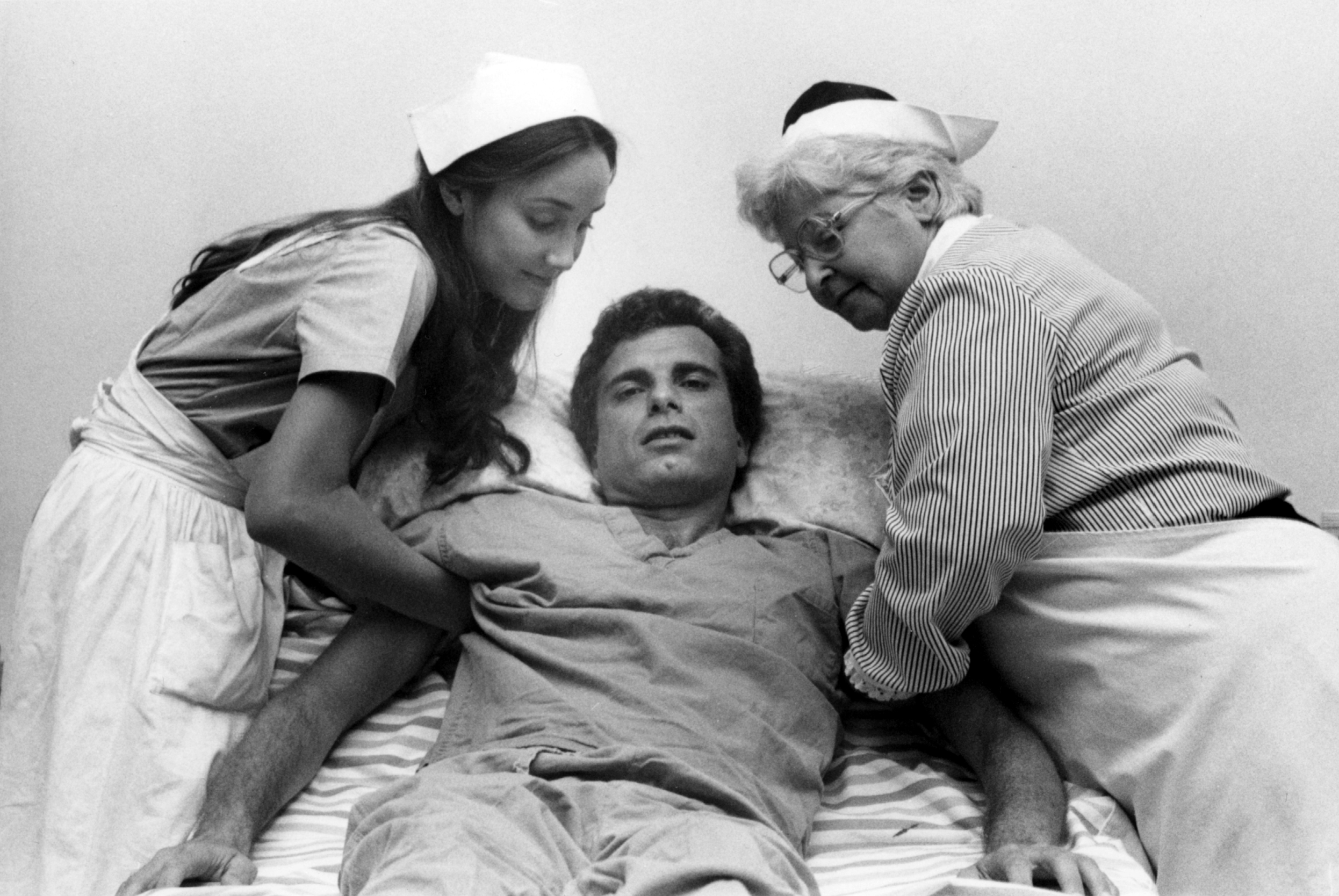
Phoenix Little Theatre. “Whose Life Is It, Anyway?” (From left, Shari Snitzer, Steven Mastroieni, Hope Silvestri.) Photo courtesy of Steven Mastroieni.
- NOVEMBER 1980
- THE NIGHT OF THE IGUANA
- Playwright: Tennessee Williams, based on his 1948 short play.
- Year Produced on Broadway: 1961.
- Director: Ruth Willis.
- Cast: Steven Mastroieni, Carolyn Paine, Melanie MacQueen, Roy Padilla, Bill Strauss.
- Sets: Keith Brian Shaw.
- Comments: I never knew Ruth Willis to deliver less than a home run when she stood up to bat. This steamy, hard-edged production of the Tennessee Williams’ drama was no exception. She drew strong performances from every member of her cast, but none more so than those of Steven Mastroieni and Carolyn Pain. Steven’s dark looks and rumbling voice added a layer of appeal to his dissolute, defrocked priest, while Carolyn went totally against type to give us a wonderfully blowsy innkeeper. Like all theater, you had to be there to experience it to the fullest. Really, you should have been.
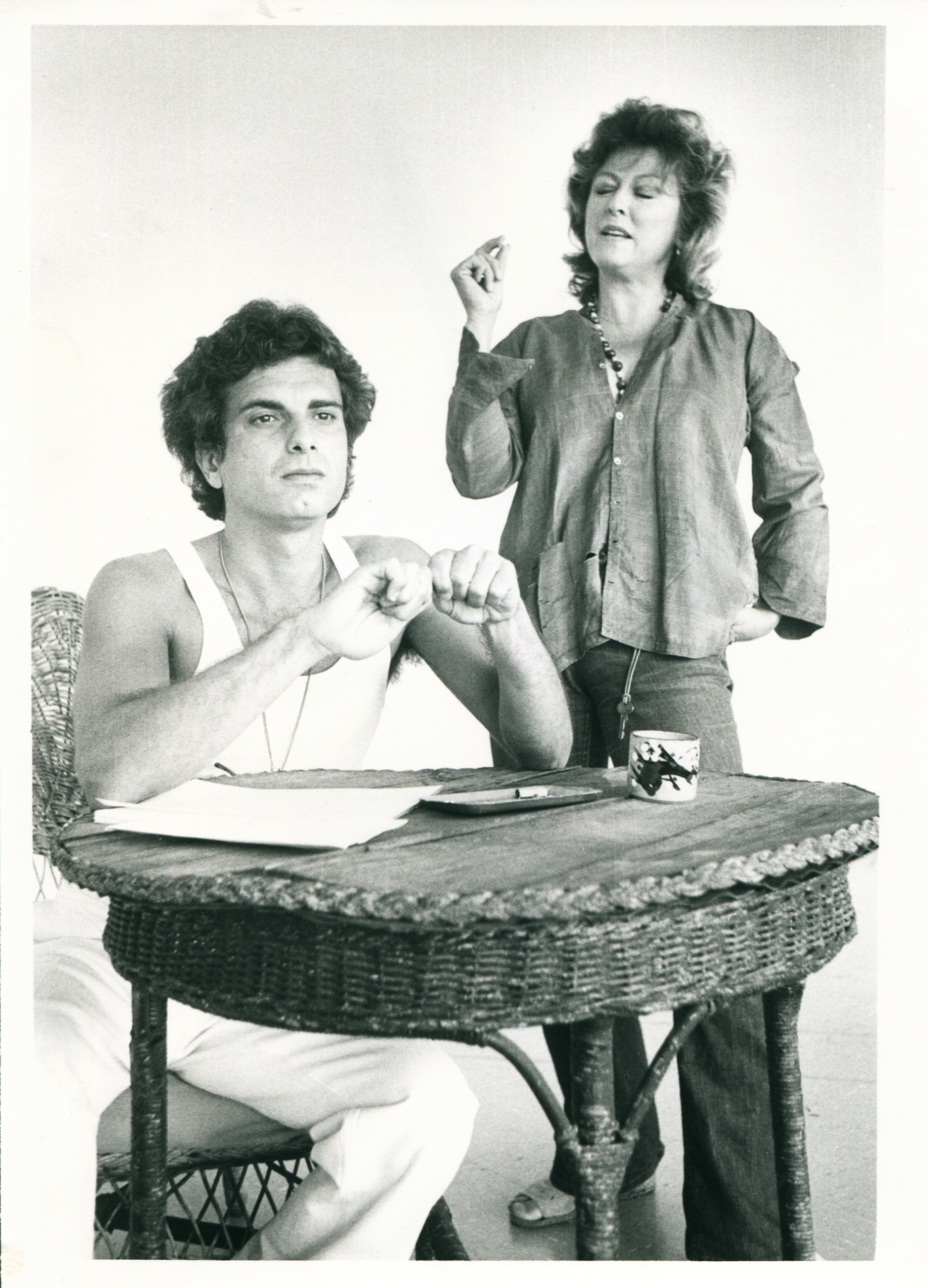
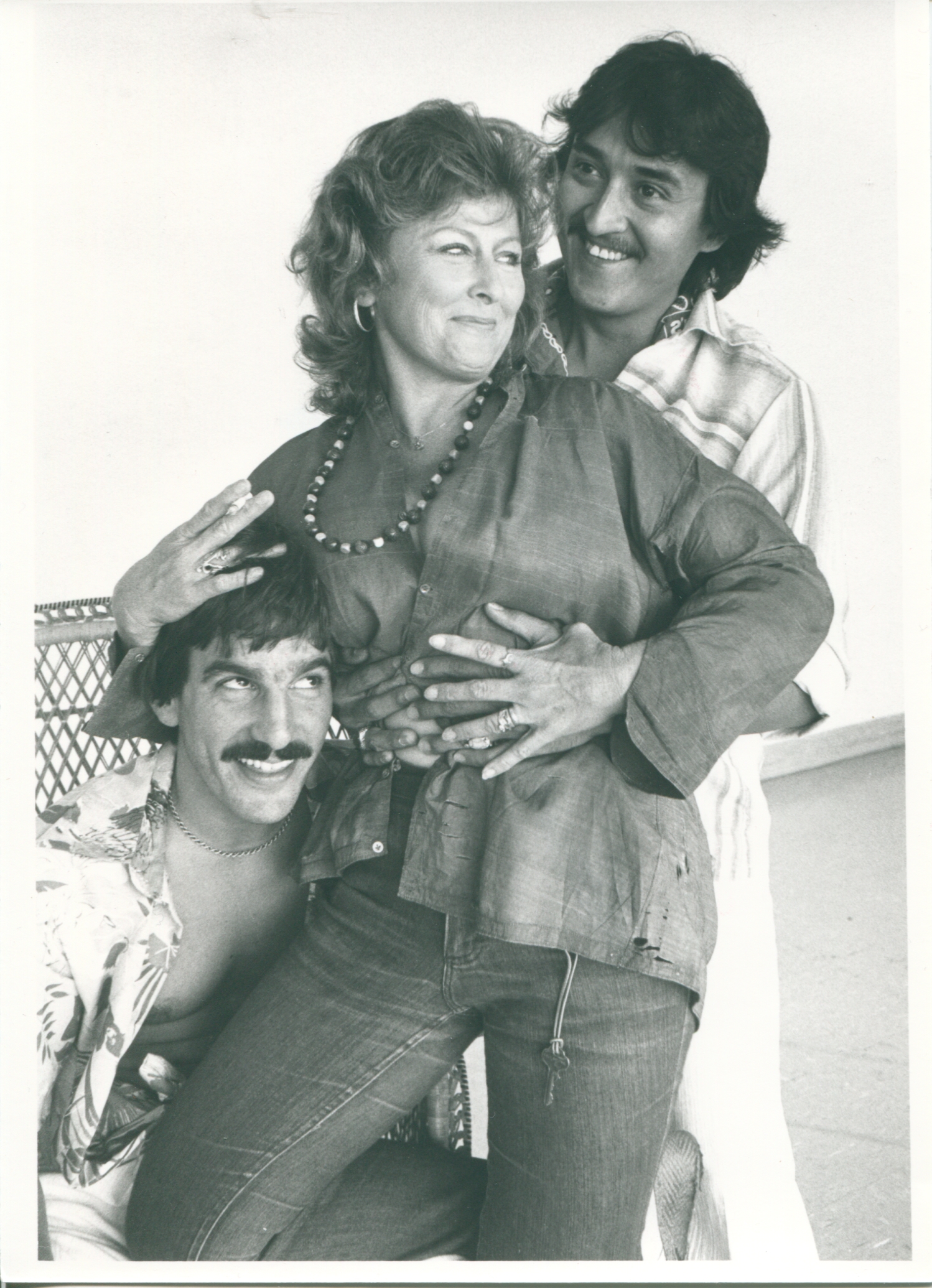
Reminisces from Steven Mastroieni: While Carolyn and I were certainly no Burton and Gardner, we served Mr. Williams text well (…) while Carolyn’s acting was stellar, her plunging decolletage did serve to upstage a bit.
- c. 1980
- DESTRY RIDES AGAIN
- Book: Leonard Gershe, based on the 1939 film starring James Stewart and Marlene Dietrich.
- Year Produced on Broadway: 1959.
- Music & Lyrics: Harold Rome.
- Director: John Waits.
- Music Director: John Clegg.
- Scenic Design: Keith Brian Shaw.
- Choreography: Noel Irick.
- Fight Choreography: Ron Nix.
- Cast: Sheldon Simon, Charlann Simon, Steven Carry, Jan Sandwich, Richard Fink, Creighton Hill, Debra Jones.
- Comments: The married Charlann and Sheldon Simon were the Valley’s musical Lunt and Fontanne, he with a robust tenor and she with a lovely, though husky, contralto. Richard Fink soon left community theaters behind to become an internationally renowned opera star who performed at the Metropolitan Opera and other houses. Jan Sandwich was one of the popular Barnstormers at the Windmill Dinner Theatre.

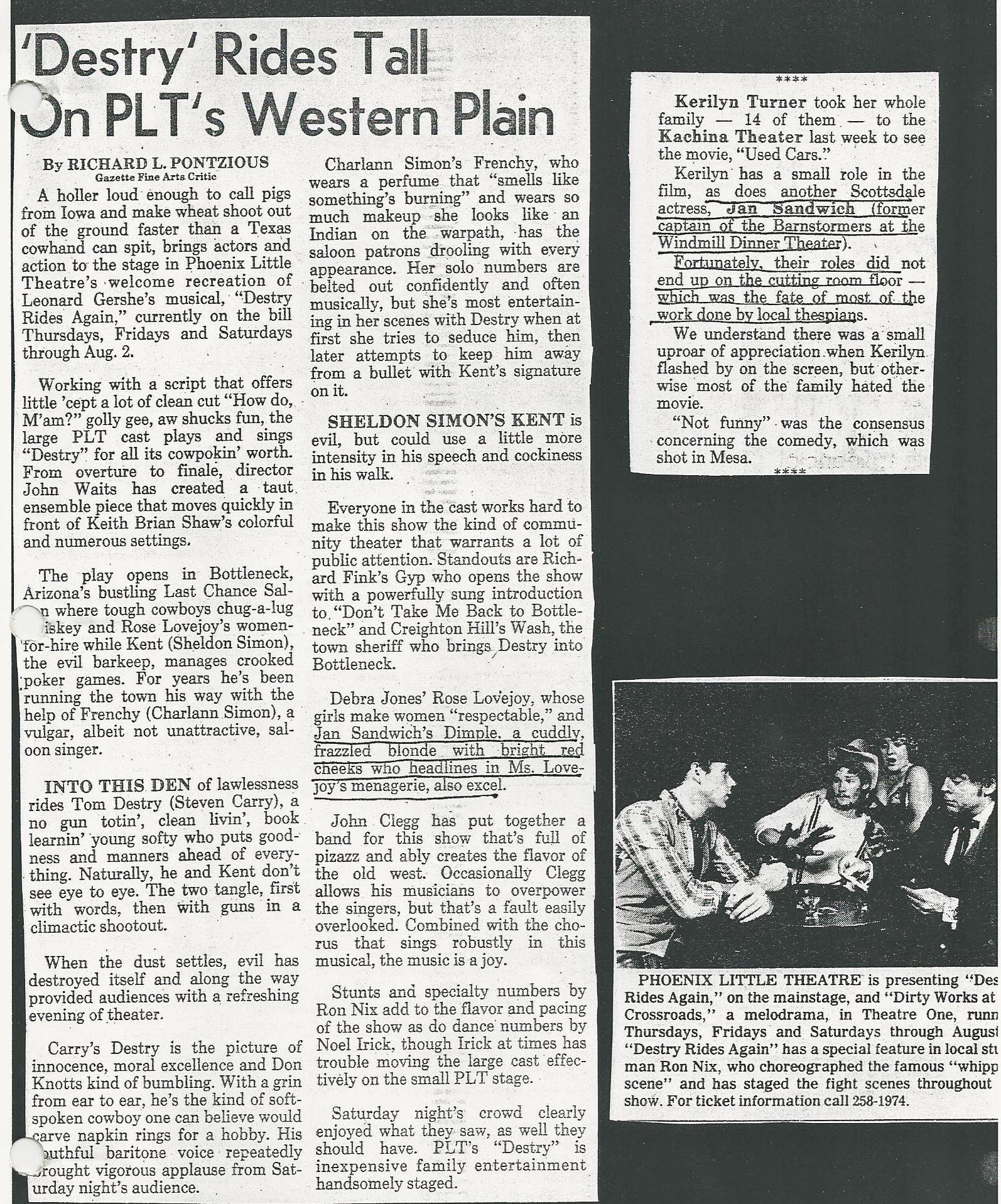
*****
- 1984
- DAMN YANKEES
- Book: George Abbott, Douglass Wallop.
- Music & Lyrics: Richard Adler.
- The story is a modern retelling of the Faust set during the 1950s in Washington, D.C., during a time when the New York Yankees dominated major league baseball. The musical is based on Wallop’s novel, The Year the Yankees Lost the Pennant.
- Director: Michael Barnard.
- Music Director: Jerry Wayne Harkey.
- Cast: Brad Craig, Victoria Brotherton, Gene Blakely, Carolyn Pain, Jan Sandwich, Art Royer, Gloria Thorpe, Suze St. John.
- Comments: If I had a favorite actor from this period, it would have to be Brad Craig, who literally exploded with talent every time he hit the stage. He died much too young, but not before he gave us some matchless performances, including his baseball playing Joe Hardy in this musical classic. This also was one of Carolyn Pain’s most memorable performances and I have always been a fan of Jan Sandwich, whom I first saw on stage as one the Windmill Dinner Theatre’s Barnstormers.
- Note: Apparently Art Royer stepped in for Gene Blakely at the last minute. No reason is given.
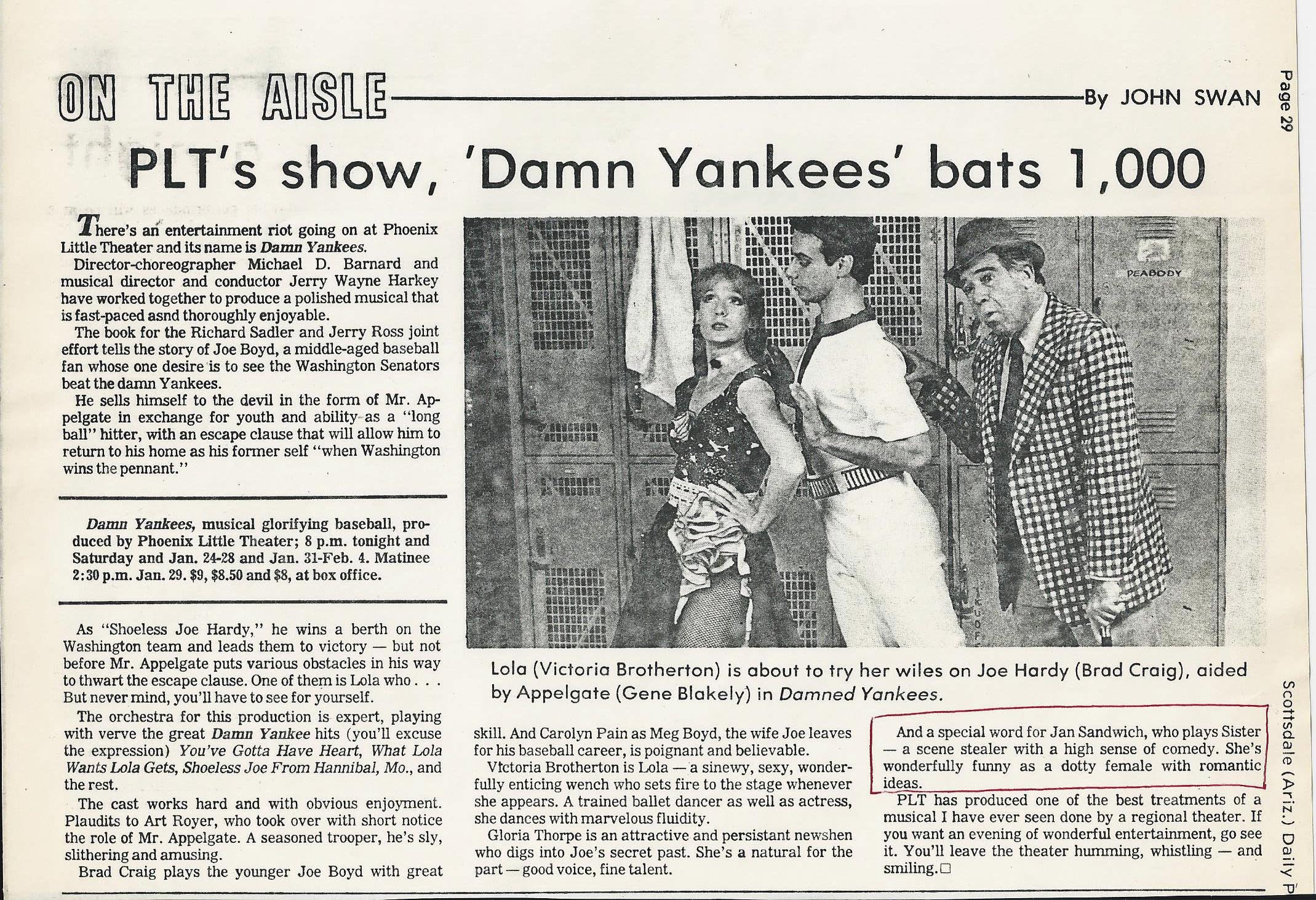
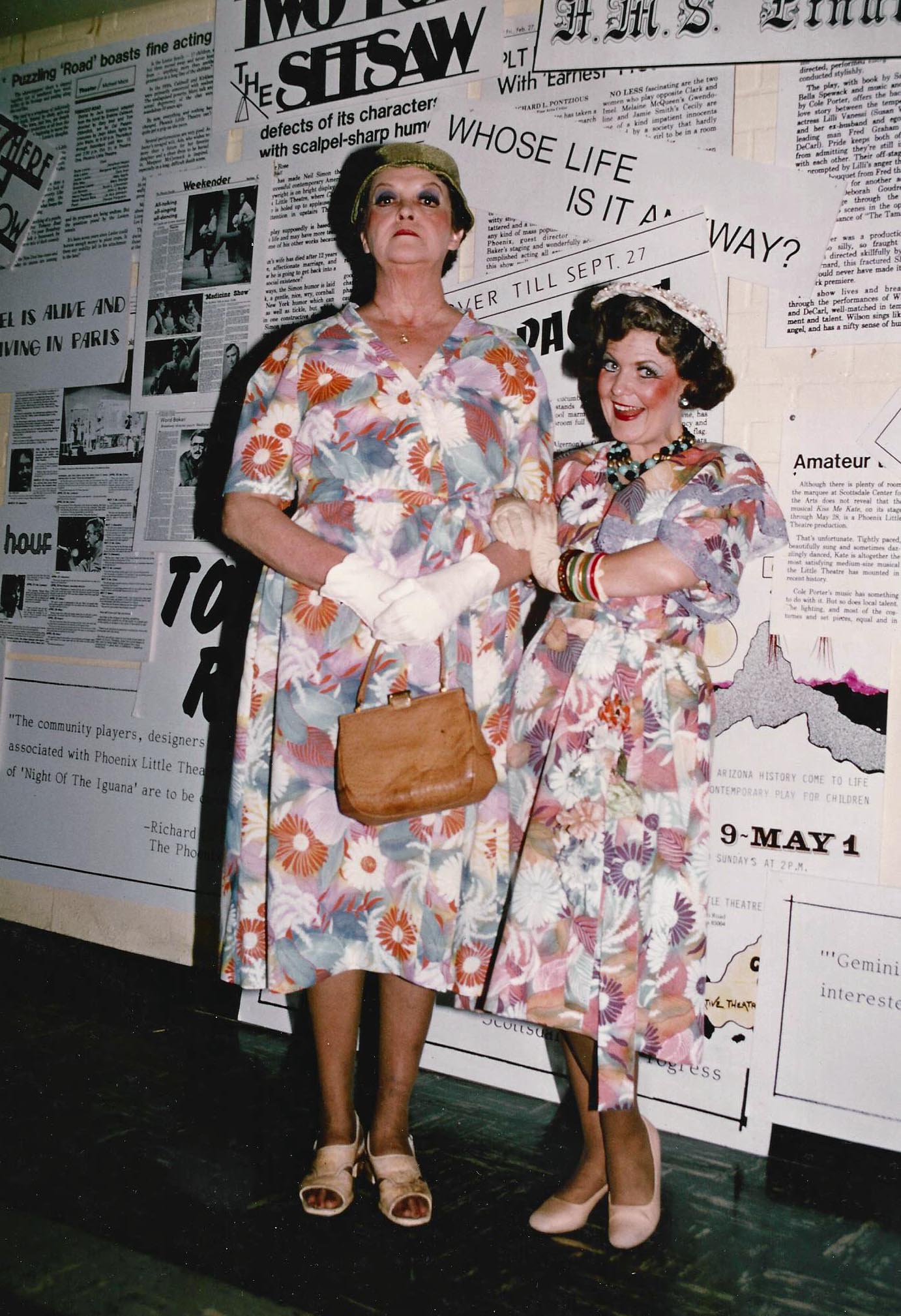
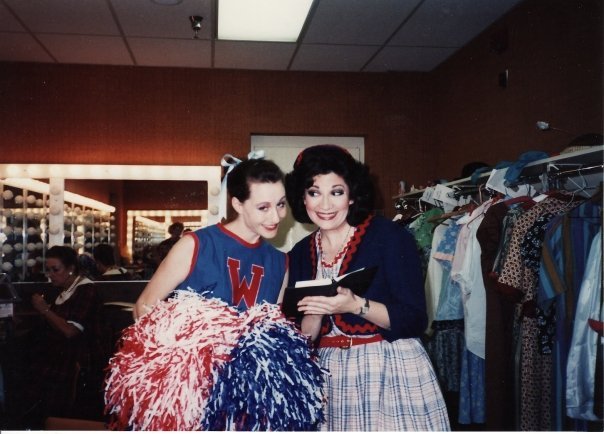
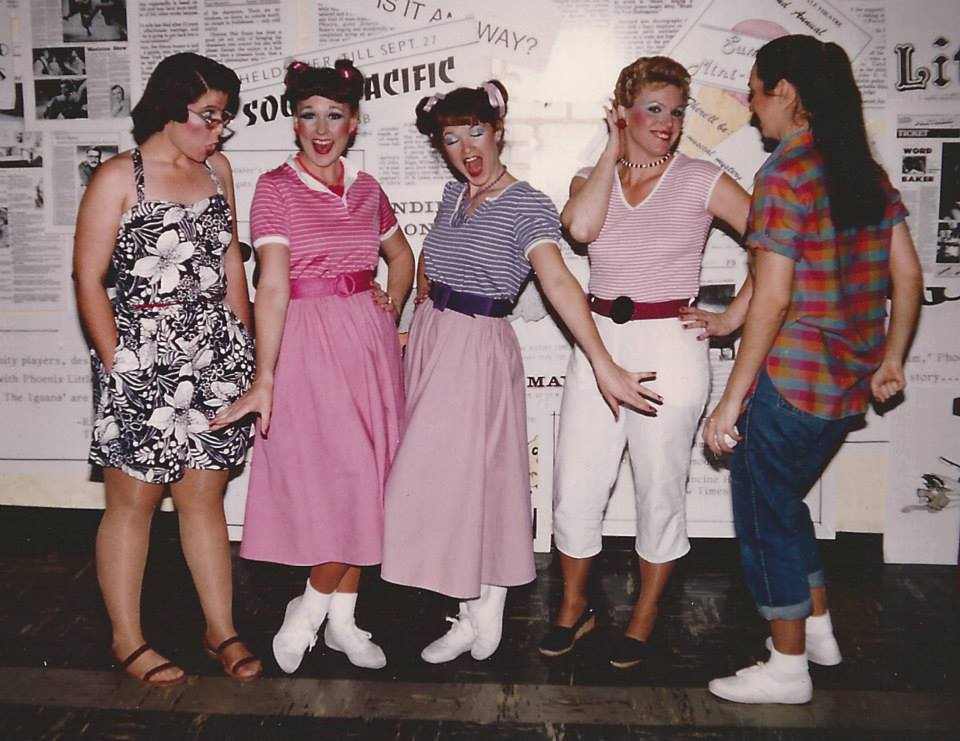
Suze St. John remembers this photograph … “A seminal moment in my acting life: Michael was (and still is) a genius at getting ensemble members to differentiate their characters. This is the Joe Hardy Fan Club – we could have been five girls in fan club gear, but instead we are an eclectic mix of interesting people: the nerdy girl, the girly twins, the sex-pot and the tomboy. I take this lesson into every show I am in and every show I direct. Thank you, Michael!”
For a detailed look at Phoenix Theatre in the 1970s go HERE
For a detailed look at Phoenix Theatre in the 1960s go HERE
For a detailed look at Phoenix Theatre in the 1950s go HERE
For a detailed look at Phoenix Theatre in the 1930s go HERE
For a detailed look at Phoenix Theatre in the 1920s go HERE

